Plywood One Sheet Surf Ski - OSSKI
by gwidders in Outside > Boats
9037 Views, 60 Favorites, 0 Comments
Plywood One Sheet Surf Ski - OSSKI
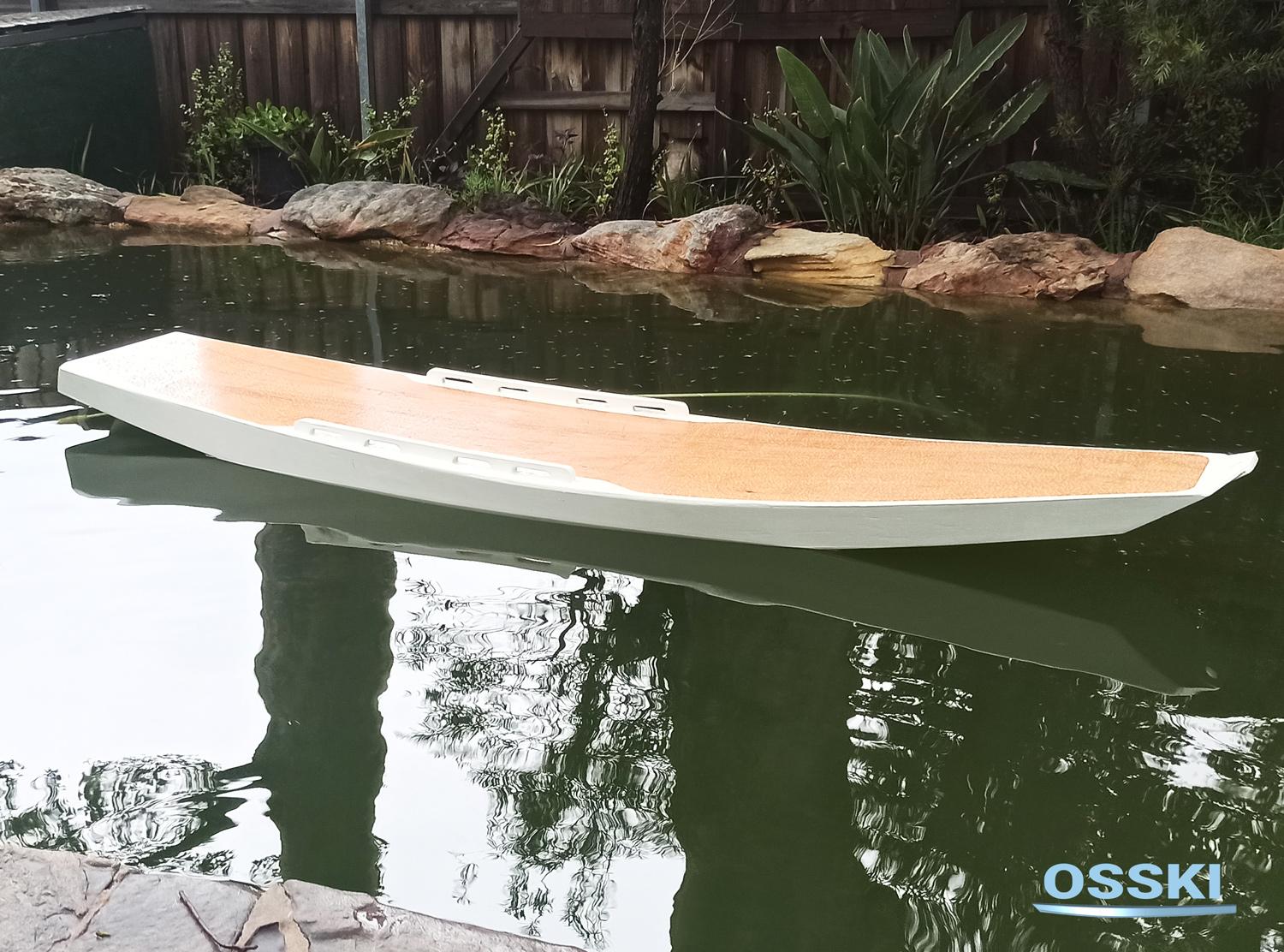

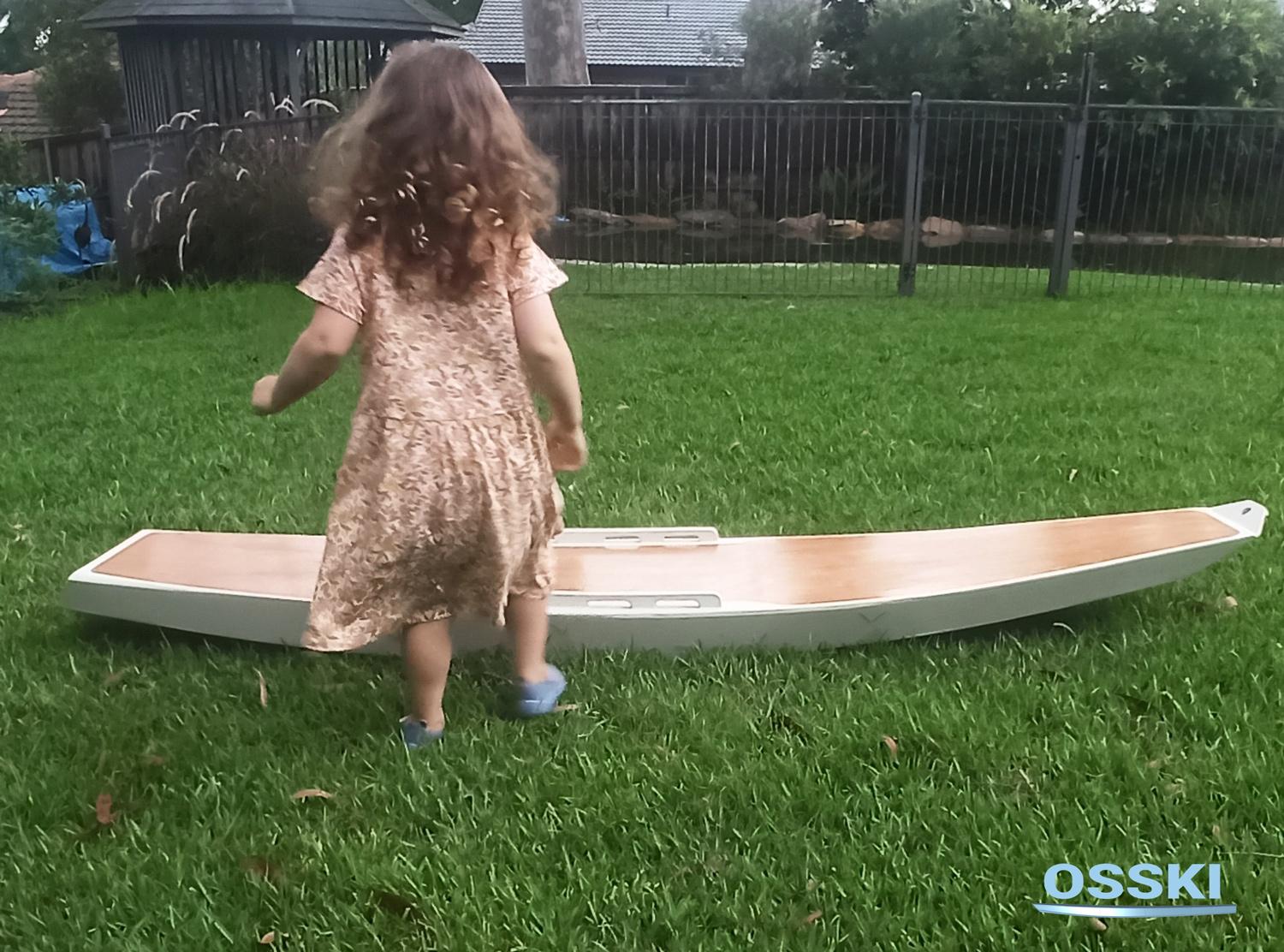
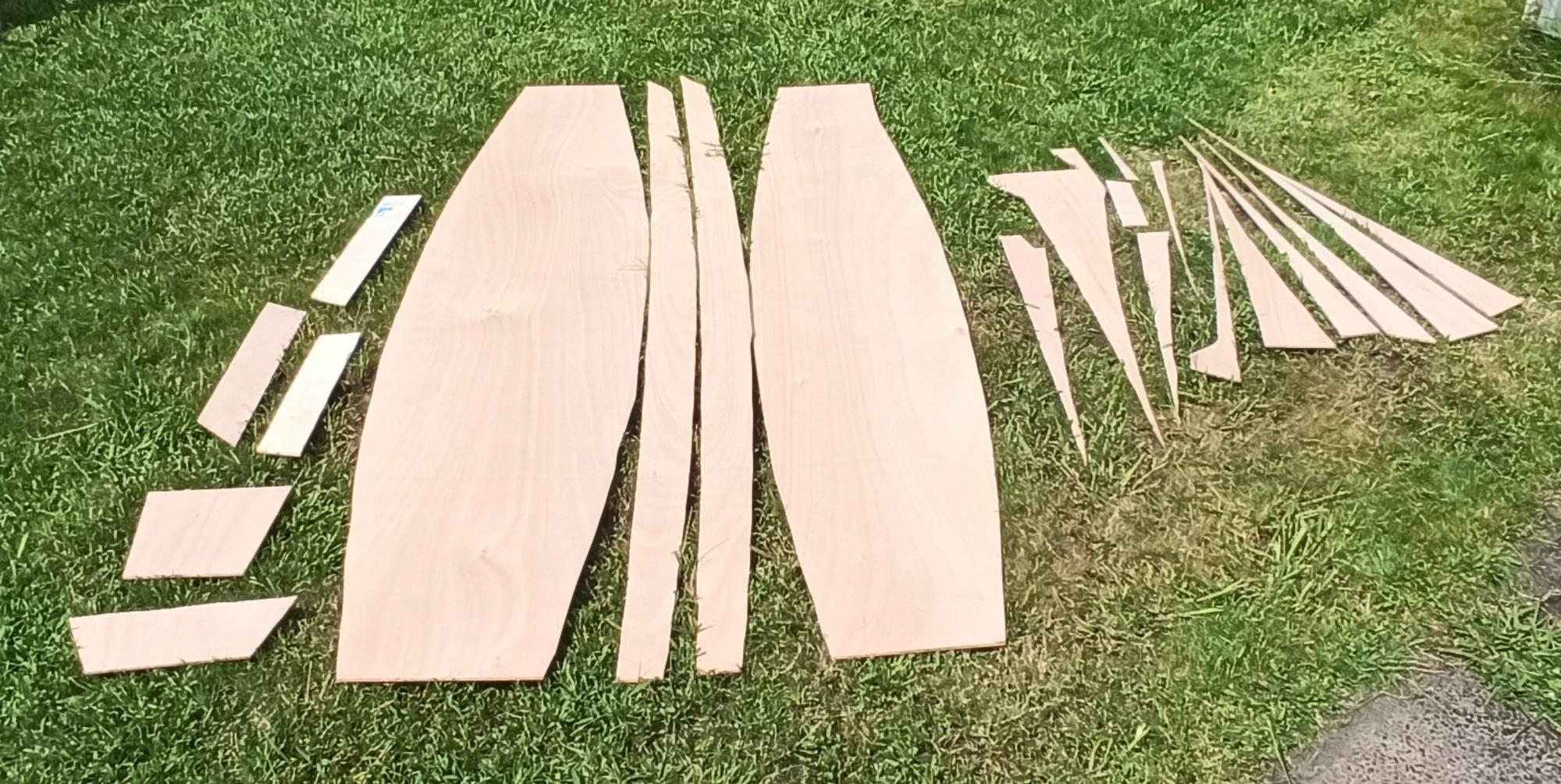
This project is all about creating a quick, cheap fun and usable kids surf ski. Based roughly on the designs of the original surf skis from the early 1900's, see here for more info. The design name OSSKI comes from one sheet surf ski.
This board is designed to comfortably support a kid up to about 50kgs. A longer and wider board would be more stable but this size fits snuggly into one standard 2440*1220 sheet of plywood without much leftover. There are a range of one sheet boat projects out there but this being a fully enclosed board I feel is a bit more appropriate for kids. If they do tip the thing over it's not going to fill up with water and they can climb back on easily without needing to bail any water out at all.
All of the parts on this build (except for a paddle) have been built out of a single 6mm board. This includes a small skeg and two handrails. The final step of this instructional suggests some other bits that could be made from offcuts - I welcome any other suggestions!
The total time to build an OSSKI should be somewhere between 15-20 hours depending on the optional extras that you add in, your level of proficiency and your expectations on finish quality.
*** Please note ***: build and use an OSSKI at your own risk. This is not an engineered safety device and should always be used with appropriate safety considerations. The woodworking and tools involved in this instructable also pose safety risks. Please be careful, wear your PPE and ask for help where you are not comfortable. There are plenty of tutorials and friendly (mostly) woodworkers/ boatbuilders out there to learn from.
A note on materials: Search what plywood is best for boat building and you will find all sorts of advice out there. Pick the material that matches your budget and expectations of durability. For the best longevity select bs1080 marine plywood. This comes in a range of different species with slightly different characteristics. Resin coating or even a layer of lightweight fiberglass cloth will extend the longevity of a boat further but at a cost.
Many boats have been built out if cheaper materials exterior ply will do the job but don't expect the boat to last too long. 'marine ply' sold in major hardware stores often isn't BS1080 but will perform better than exterior ply.
Supplies
Materials:
- 6mm Marine plywood sheet (1220x2440mm)
- Epoxy Resin (approx. 0.6 liter)
- High strength glue filler powder for resin
- Lightweight filler powder for fairing.
- Varnish
- Undercoat paint
- Topcoat paint
- Fiberglass cloth (offcuts from other jobs or 40mm fiberglass tape)
Tools:
- Pencils
- 1m Ruler
- Tape measure
- Jigsaw (wood blades preferably with a higher tooth count)
- Drill + Bits
- Hole saw
- Bandsaw or Table saw (or access to someone with one)
- Hand saw
- Hand plane
- Stanley knife or similar
- Spokeshave
- Scissors (To cut fiberglass cloth)
- Wire snips
- Disposable Gloves
- Plyers (needle nosed work best)
- Paintbrushes - a few cheap brushes for fiberglassing and a couple for painting.
- Painters tape
- Sandpaper (120, 180, 240 grit)
- Long flexible straight edge (approx 2.4m) Aluminium or timber as long as it's straight and a bit flexible.
- Weights (full paint tins will work, 5-10 of these should be enough.
- Clamps - you can never have too many clamps for boat building.
Draw Up Your Parts - (Approx. 2-3hr Solo)

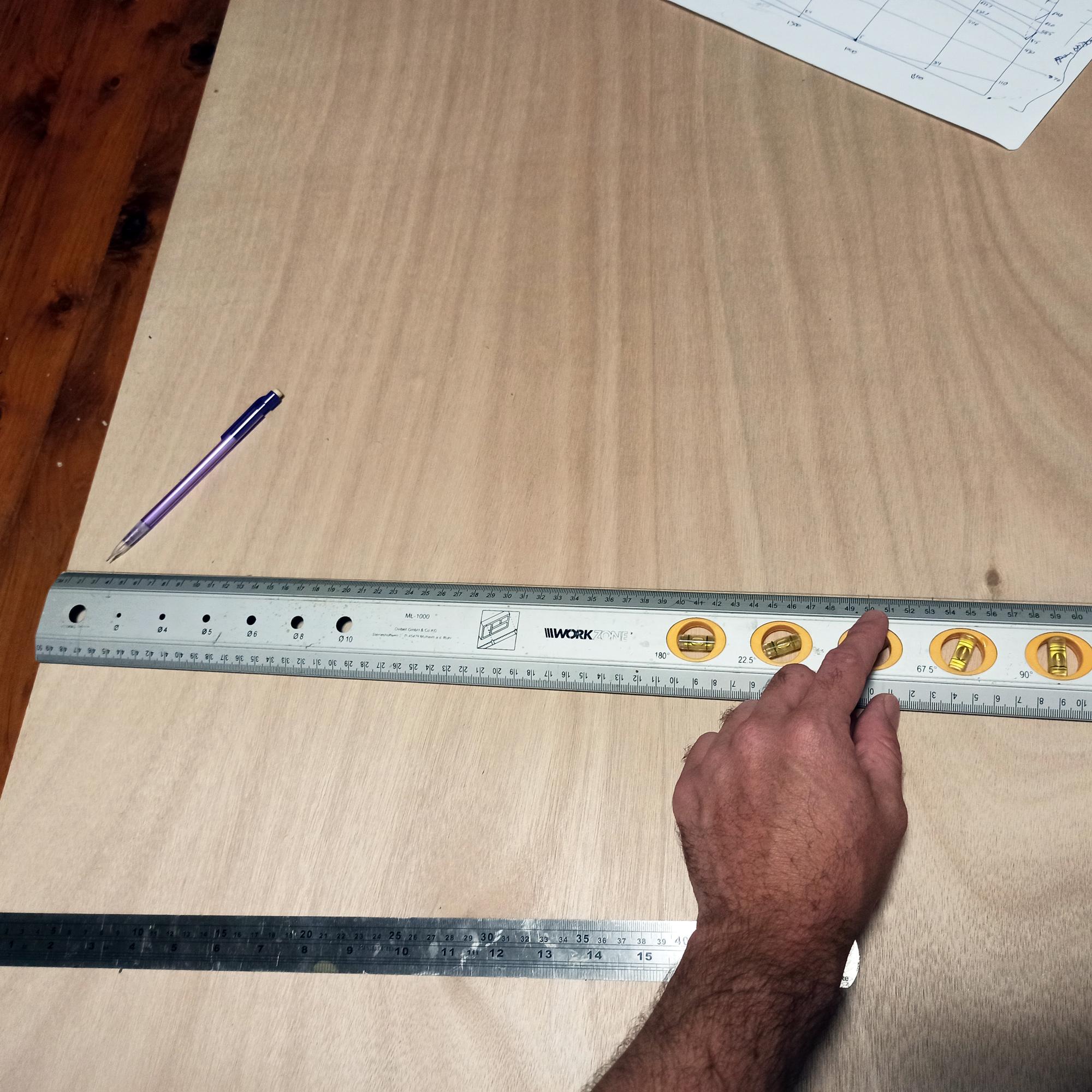

Tools:
- 1m or longer ruler.
- Long flexible straight edge batten (piece of timber or aluminium rectangle profile work well for this)
- Pencil
- Eraser
- 5* weights (cans of paint or beans or anything with a bit of weight to it will do)
For the dimensions to create the OSSKI please use the PDF attached to this step. This document walks through a step by step instruction for how to make up your sheet of plywood. Some tips below for as you go through these steps...
- When marking out dimensions along the lines drawn across your sheet of ply, you can hold the ruler in place as shown in the image second image for this step. Mark each dimension up along the line keeping the ruler held in place.
- Make sure you mark the bottom panel of the boat from the top edge of your material as shown in the instructions.
- Join the dots to create curves - use a long flexible piece of wood or metal. Use a weight at each point that the line needs to intersect to hold the curve in place while you draw the line. (This stage could be quicker with an assistant) Start at the bottom most curve and work your way up the board. Check each point a couple of times after each adjustment to make sure all lines are intersecting at the right point. This will ensure a smooth curved line. Tip - if something looks wrong, if your batten isn't easily forming against the lines and it feels like something you might be trying to join points that shouldn't be joined, something most likely is wrong! Check you aren't trying to join a dot that should be part of a different line, or check your dimensions again if everything really looks out of place.
- When drawing in your bulkheads, bow and transom, you might find different ways to lay them out than suggested in the attached document... But what you need to look for is keeping the scrap leftover wood in chunks as large as possible. This wood will be used later!
- Make sure to mark which side of the line to cut particularly where you have multiple lines. Use an eraser to remove unneeded lines to avoid confusion when it comes to cutting.
Notes* check once all parts are drawn that there is approx. 5mm clearance between each part. This allows some room (not much) for cutting out the panels with a jigsaw.
Downloads
Cut Out All the Parts (1hr)
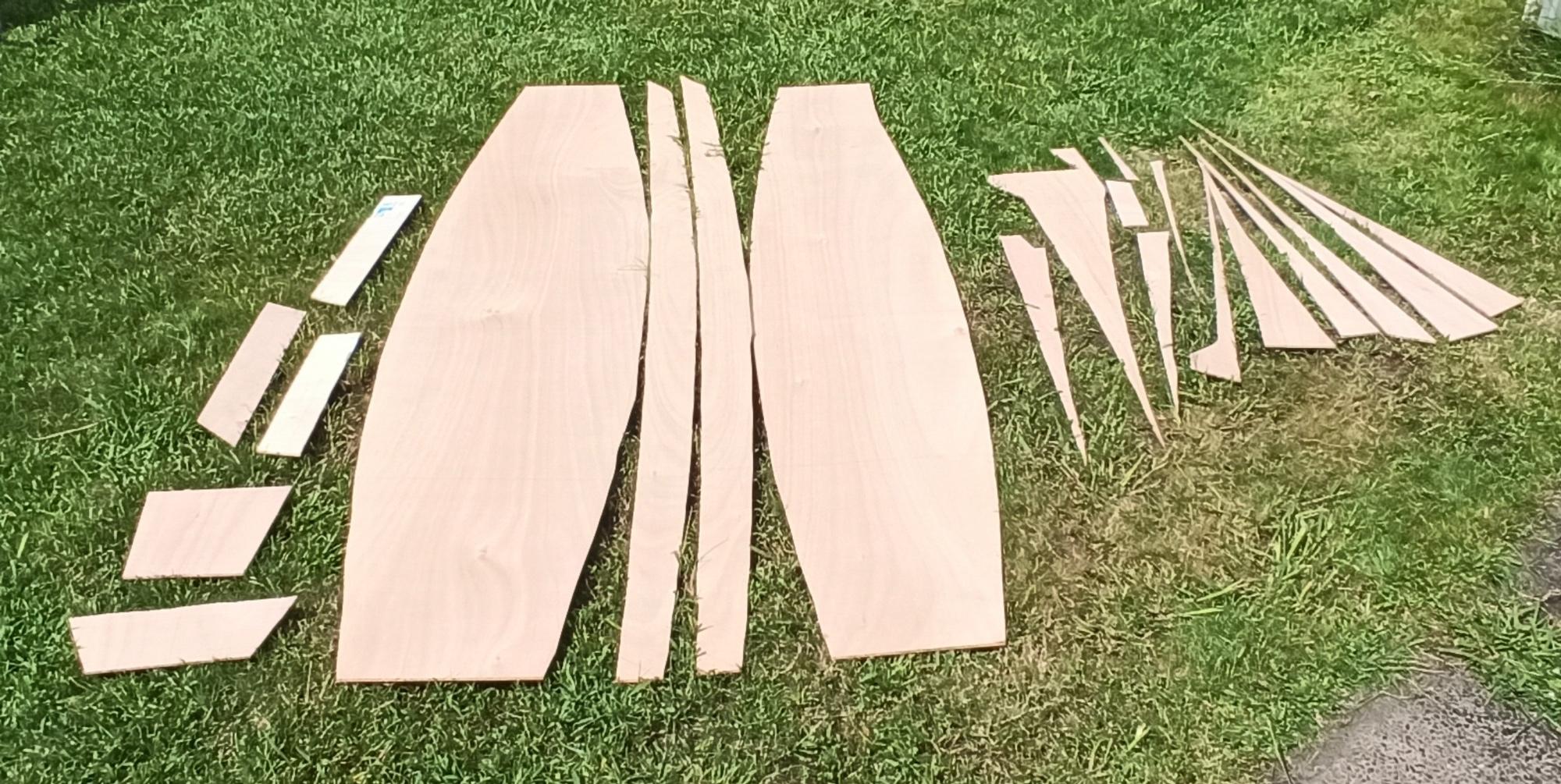
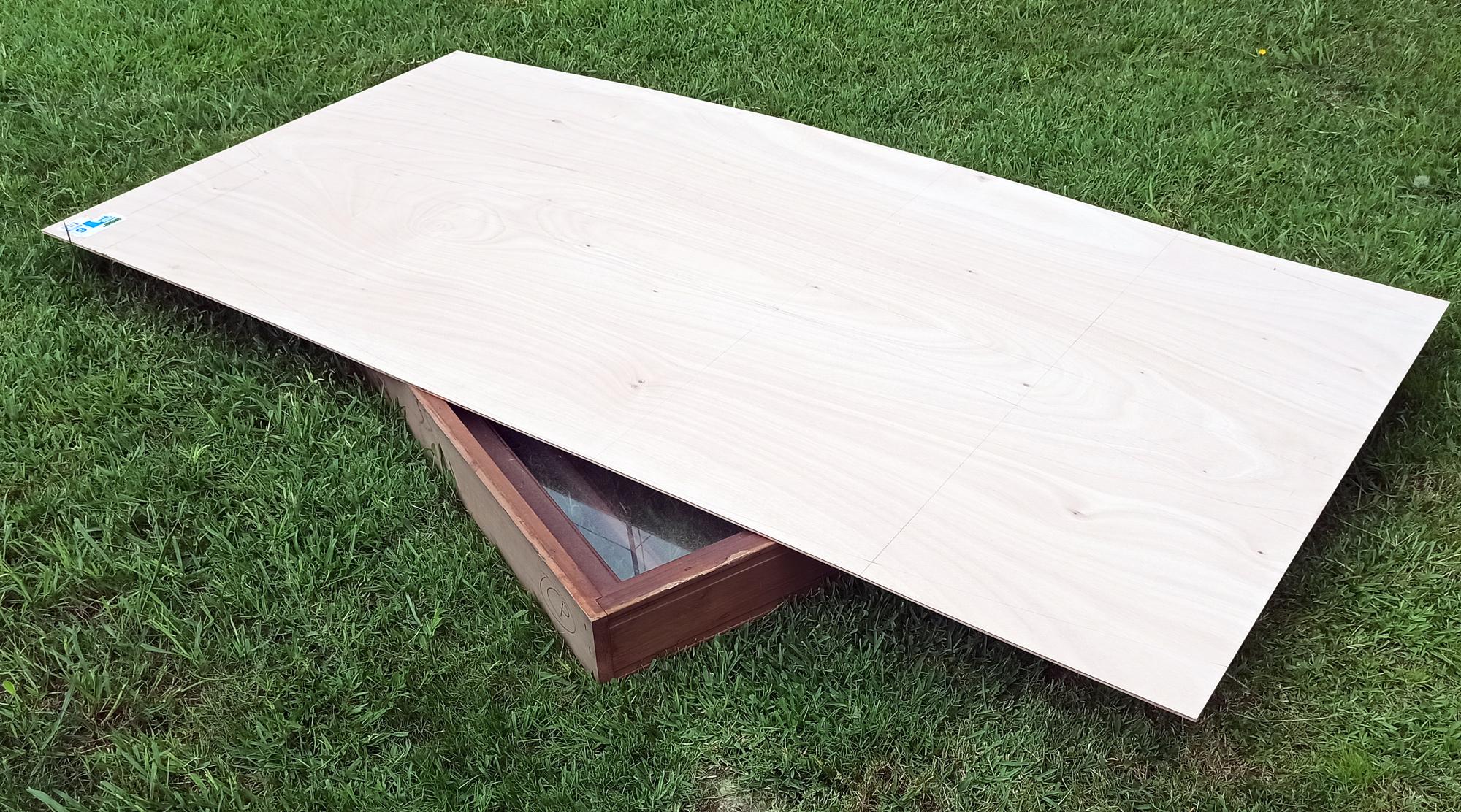
Tools needed:
- Bench or sawhorse or something to lay plywood sheet on (see below)
- Jigsaw with timber blades (preferably high tooth count)
- The tolerances between parts is quite small so use a jigsaw blade with a higher tooth count to avoid tear out, and be as accurate as possible. This is particularly important when using cheaper lower quality materials as plywood plywood with more voids and imperfections has a higher tendency to tear.
- Don’t cut to the line but leave only a few mm outside, and even more for the deck panel. Take your time in this step as accuracy will reduce your planning time in later steps.
- If you have a big enough bench to lay your board out on use that. Otherwise you can rig up saw horses or basically anything that gets the plywood a little bit up off the ground. I've used a window frame here that I had lying around.
- When cutting with your jigsaw check your blade isn't going to hit anything. Then check again before you start to avoid rude shocks.
- I started with the molds, bow and transom piece before tackling the pieces of the hull. Make as few cuts into the scrap wood as you can to leave larger offcut sections. this material will be used to make other bits and pieces for the boat later.
- Once all cut up, put the boat pieces together in one lot and keep all your scrap together as well (don't mix the two up)
- If you are planning to add a tow rope to the bow like in this prototype make the bow section a lot longer at the top of the given dimensions
Trim and Fair Your Cut Parts to Size (1hr)

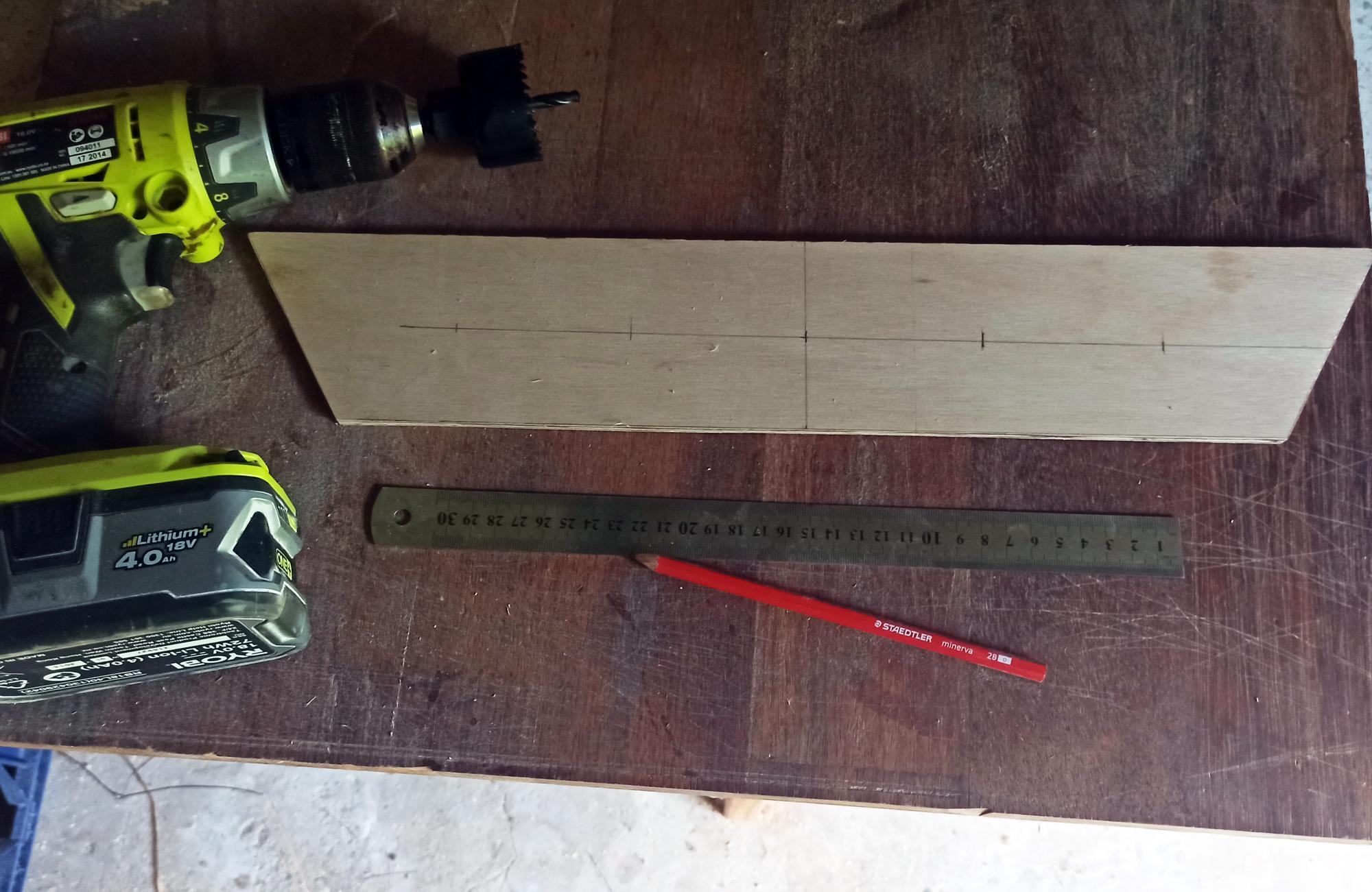

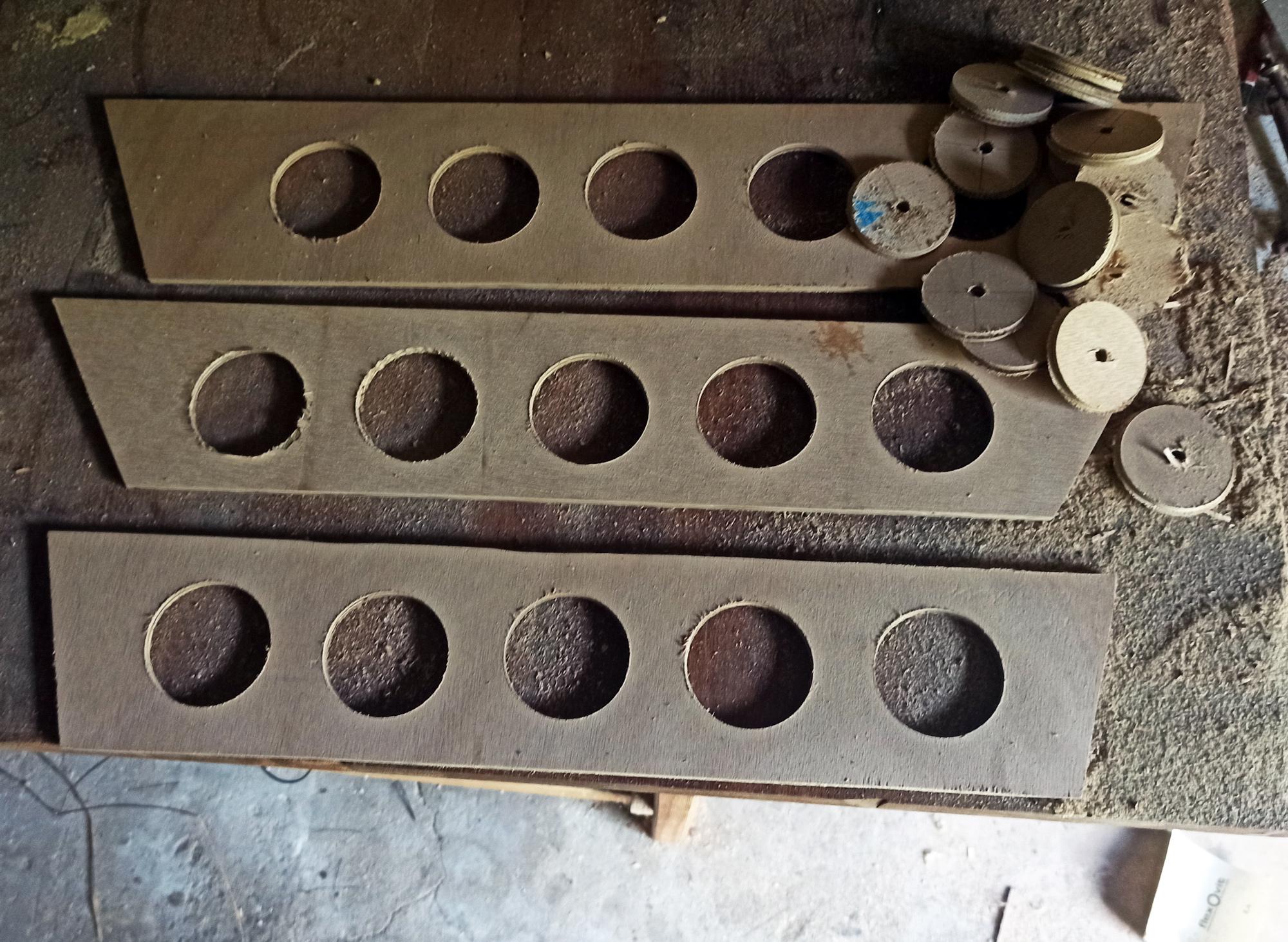
Tools Needed:
- Hand Plane
- Handsaw (highly recommend pull cut Japanese saw for accurate cutting)
- Optional - Drill and Holesaw
- Use a hand plane or handsaw depending on how much trimming is needed… trim to the line on all parts except the deck, upper edges of the hull sides, transom and bow. These parts will be trimmed to fit later and any material you can leave on now could help this process.
- Sharp tools are your friend in these steps. The difference between trying to plane with a sharp vs blunt blade is very noticeable. Particularly on your arms the next day if you are using the plane for a while.
- Optional: Use your hole saw to drill lightening holes into the bulkheads. Make sure you don't do this to the bow and transom! These need to stay solid. Keep a bit of material around each hole and measure the center points if each circle to keep the holes balanced side to side like shown here. I used a 50mm hole saw.
- You can also cut different shapes to lighten the bulkheads with your jigsaw or a scroll saw if you have access to it. I have chose to use a hole saw because it's quick, and there are some fairly inexpensive hole saw bits available.
- Tip - don't go all the way through your plywood with the hole saw from one side. Cut a few mm into the first side and then flip it over. This will ensure a clean cut with no tear out. As shown in the images here.
- If you don't use a hole saw to lighten the bulkhead, at the very least drill a couple of holes into each bulkhead to allow air to move between the sections of the boat.
Create Strips From Offcut Materials (0.5hrs + Extra for Optional Steps)

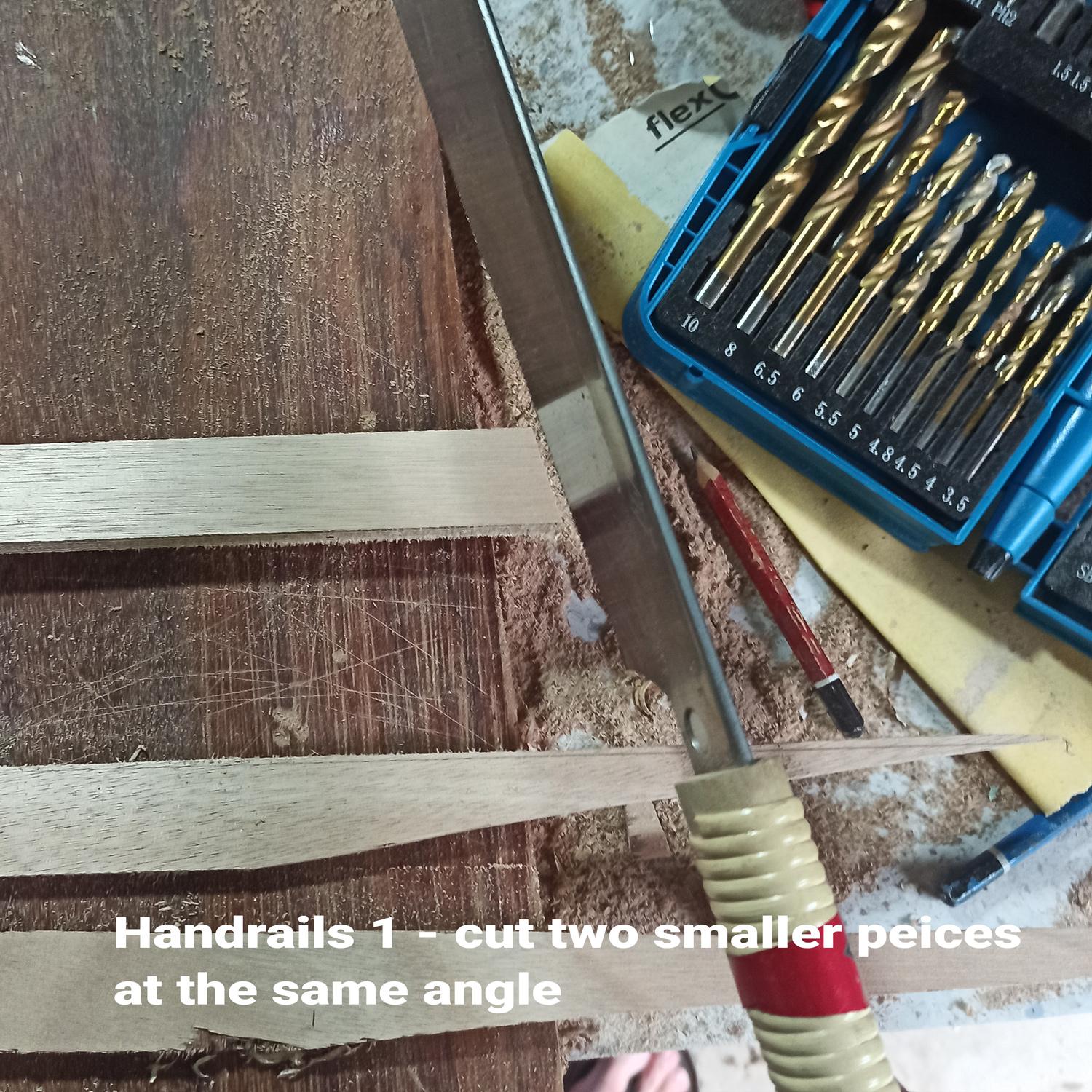
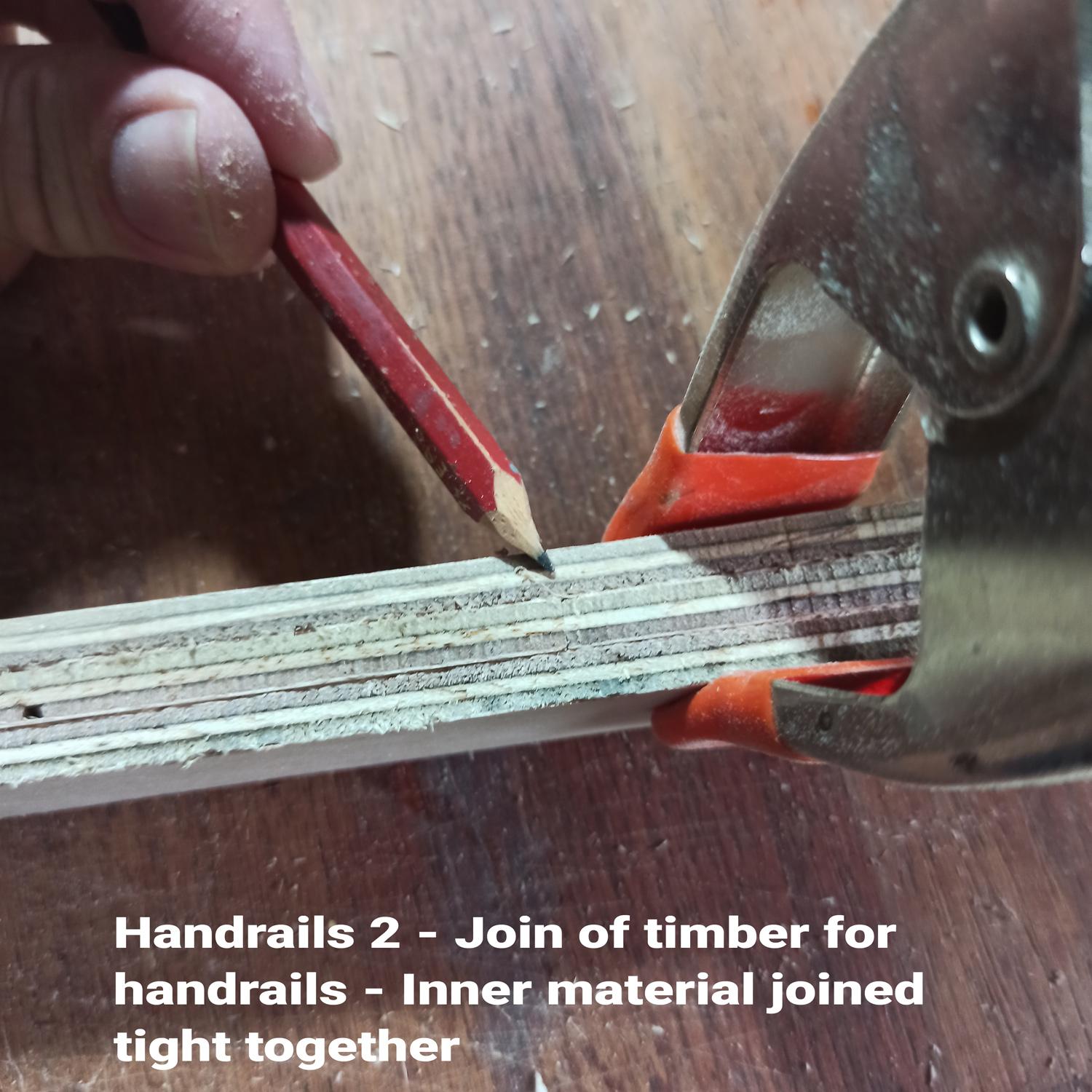
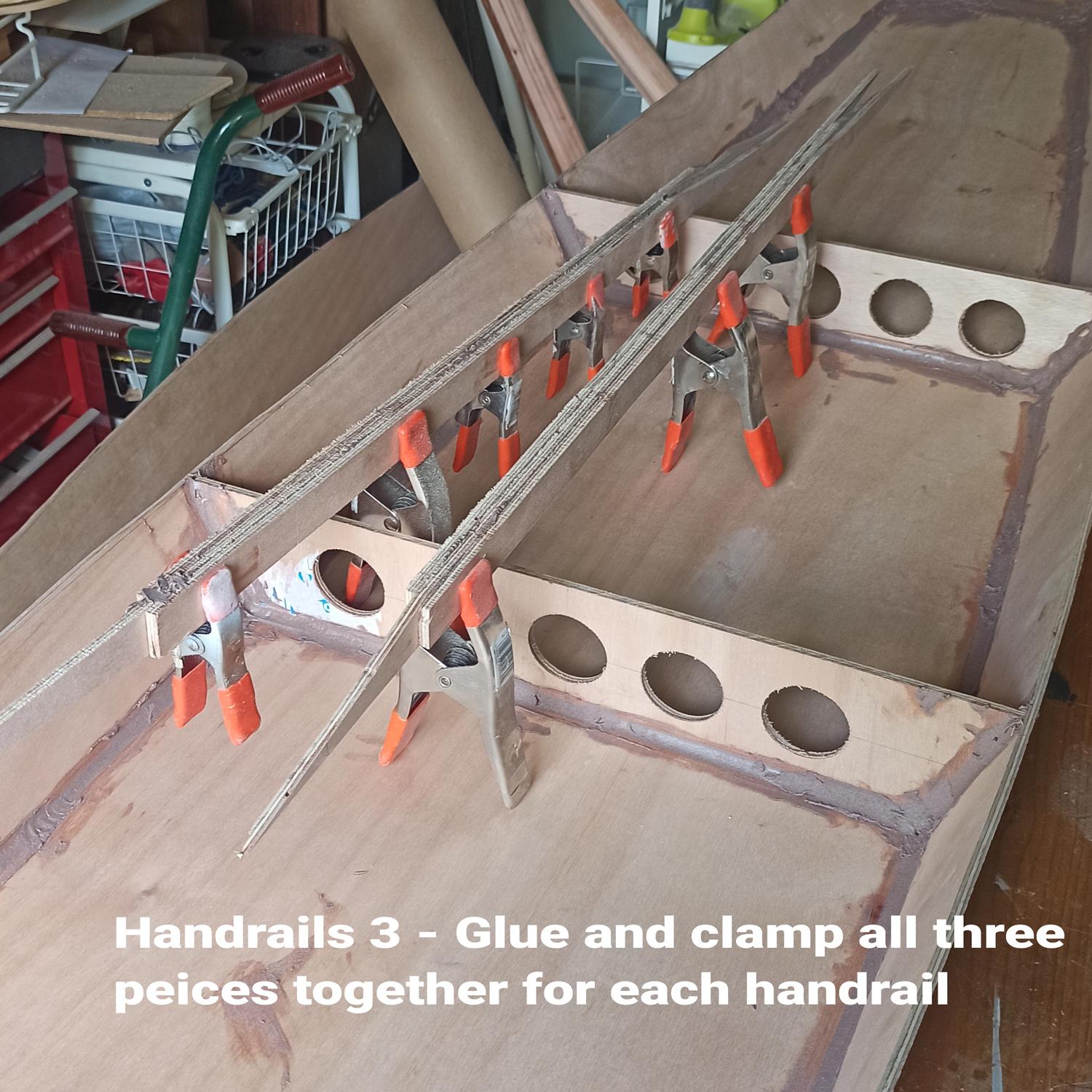


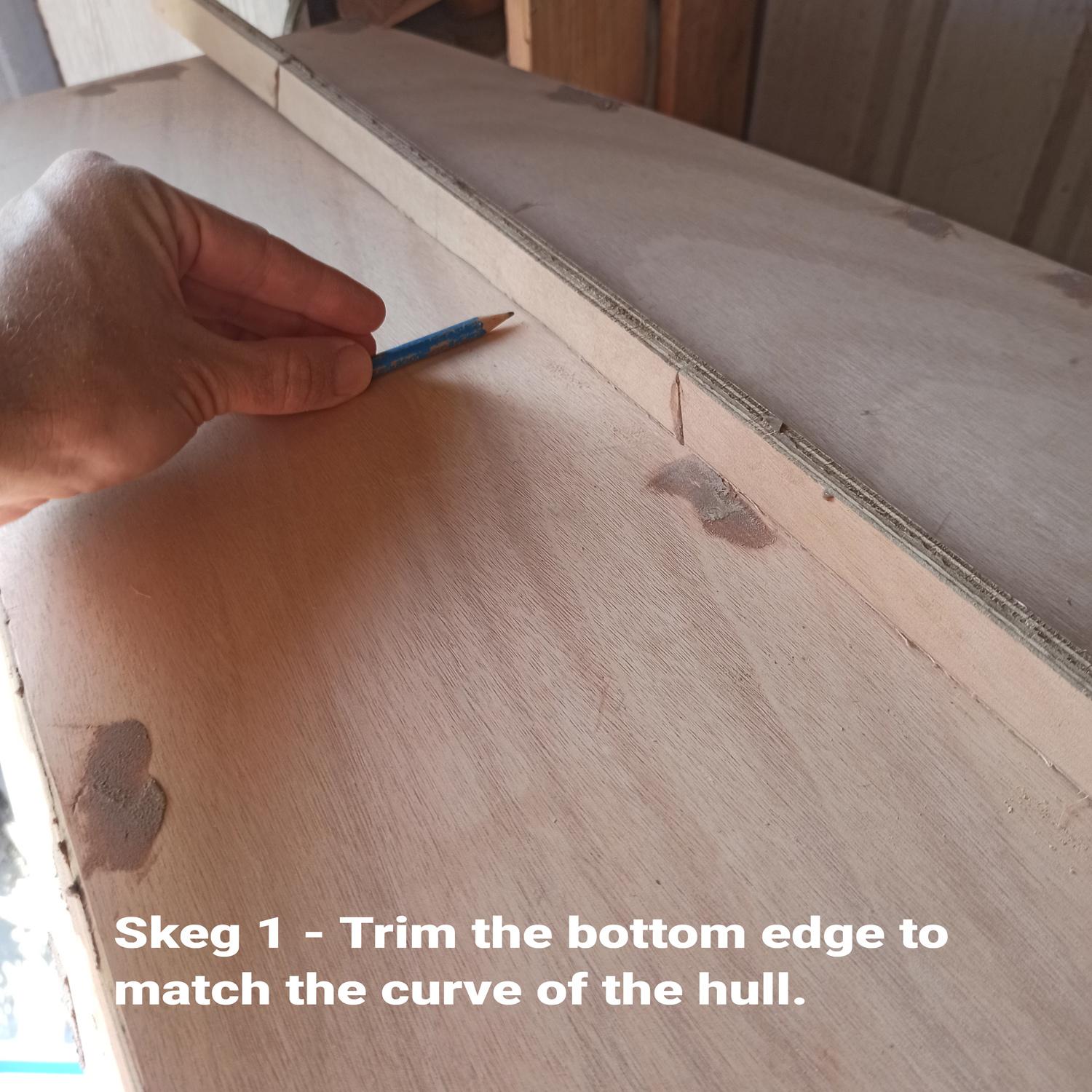
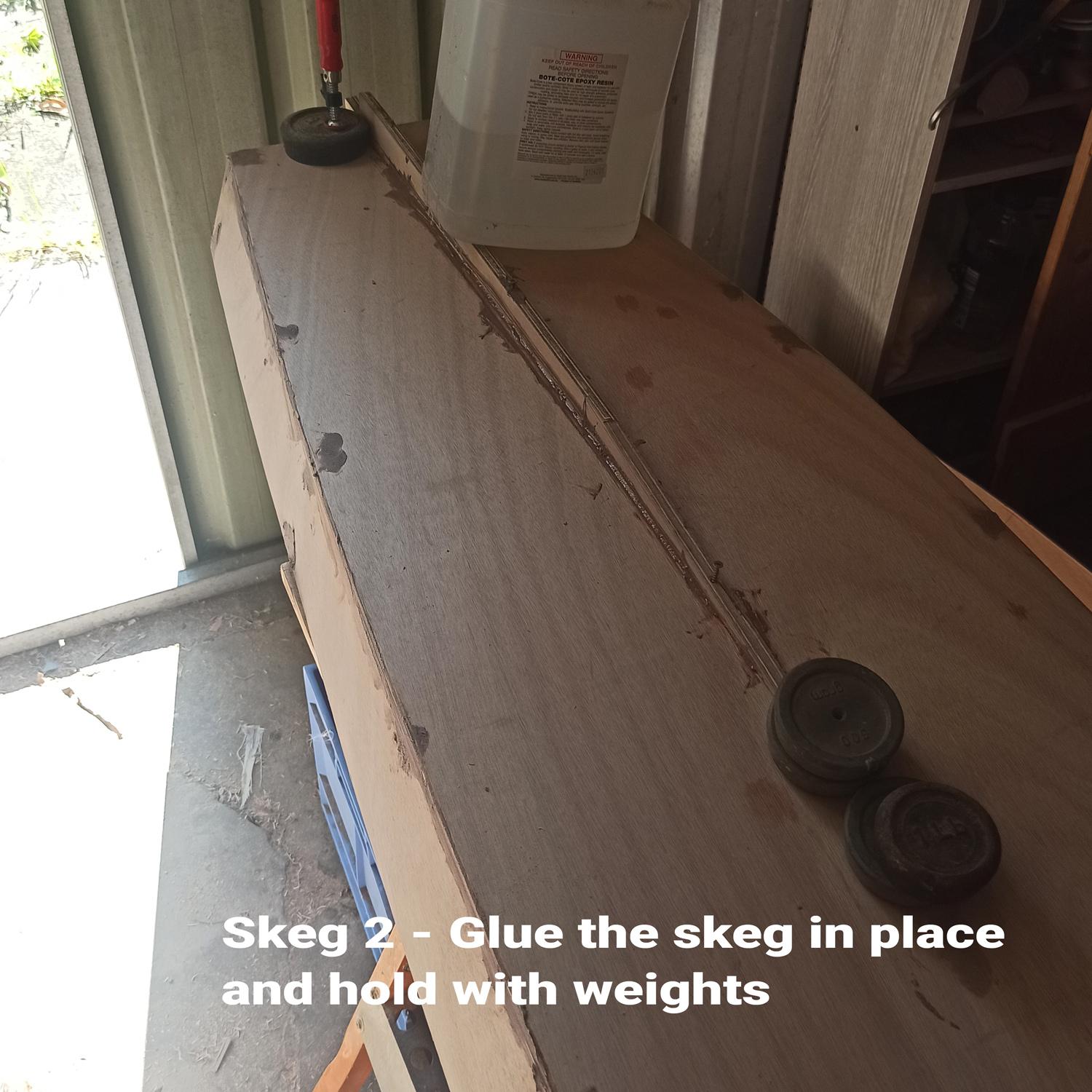
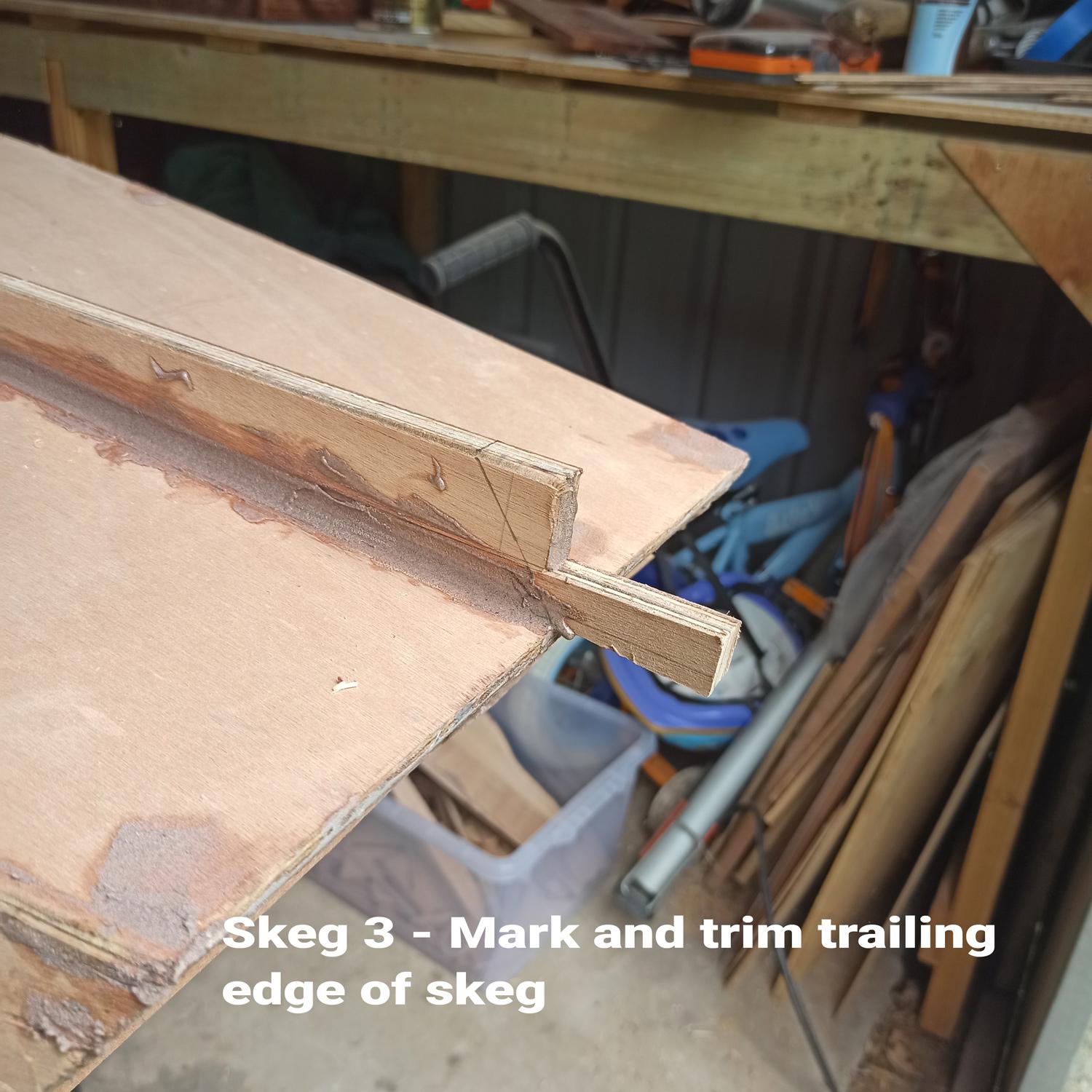
Tools Needed:
- Table saw, or bandsaw
- Using a table saw or bandsaw take your offcuts from the cutting step and turn these into strips approx. 28-30mm wide. Cut most of this material until you have lengths less than 20cm long (like you can see in the image here). These strips will be used to create handrails and a skeg on the bottom of the hull.
- Take 4 strips of material that are just over 500mm in length and store these to the side. These materials are important and will be used later under the deck to add strength.
The below instructions are for optional additions to this project that I have added into the prototype. I often find when mixing up glue there is a little bit extra left over... Having small projects that can be glued up with this extra glue always makes me feel better! I have added the full steps for the handrails and skeg below here but you will need to have more of the boat completed to add these in... Prepare the timber if you are going to add these in and glue them up when you are mixing glue for other parts in the boat.
Handrails Optional: Approx. 2hrs extra
- Find two longer strips from the offcuts with 600mm in length and 28mm wide. Find two smaller pieces to form the core. Put these two pieces together end to end and cut them at a matching angle (handrails image 1). Glue the two smaller strips inside the two longer pieces using the new cut as where the smaller pieces join inside the glue up (handrails image 2).
- Repeat the above to make a second handrail.
- Trim the edges of the glue up and round over the top edge. Trace a cutout pattern as shown along the bottom edge of the handrail. I cut these with a scroll saw which leaves a much finer finish than a jigsaw, but with a bit of care a jigsaw could probably do this job too.
- Trim all edges as desired, round over corners with a plane or sandpaper except the bottom edge. test the fit against the deck of the boat. Trim to adjust as needed to get a clean fit here (Handrails image 4)
- Dry fit the handrails in location before gluing. The angles may need to be trimmed to fit the deck curve, or they may bend into place. Make sure you clamp them down so that the whole hand rail touches the deck for a nice strong glue bond. (handrails image 5)
- Fit your handrails with the back edge approximately 650mm from the back of the deck. Keep them nice and wide on the board to allow more room to sit, as well as getting the gluing point close to the edge for maximum strength.
- Apply filler around the base of the handrails and smooth this out with a finger in a disposable glove. Sand to fair. I made the handrails fit inside the panted section of my boat. See the images later in this instructable for how to tape to paint a clean line.
Skeg - Optional: Approx. 1.5hr extra
A skeg helps a boat track in a straight line when paddling along. There may not be enough material left over from our single sheet to make a substantial sized skeg but it’s possible to make something that will have an impact when paddling, or serve as an attachment point for a larger skeg (removable or otherwise)
- Take the longest piece of scrap you can find and laminate this up with smaller pieces to create a 12mmx 28mm piece.
- Plane one edge of this piece to fit the curve of the bottom of the hull. A spokeshave will likely be your best tool here. To help you match the curve of the hull you can hold the skeg roughly in place and put a pencil against the flat bottom of the hull. drag the pencil along the hull. The tip will be raised off to bottom of the hull and leave you with a line that matches the curve of the hull (See skeg image 1) You may want to let the back edge of the skeg sit up off the bottom of the hull to get more height. 80% of the length of your first bit of skeg should be touching the bottom of the hull. you can fill this with more of your leftover plywood and epoxy glue (See skeg image 3)
- Glue the skeg into place aligning this with the center of the boat at the transom and at the leading edge of the skeg. Screw through the skeg into the hull to locate it in place (pre drill these holes as the skeg is easy to split screwing through this way)
- Use weights to help hold the skeg down along the whole length. (skeg image 2)
- Trim the back edge of the skeg and Filet the join from skeg to hull and sand fair. A nice large fillet here will help add some strength to the join of the skeg to the hull. (See skeg image 3)
- Plane the other edge of the skeg and round the sharp edges with a plane and/ or sandpaper.
Stitch the Hull Together (1.5hrs)


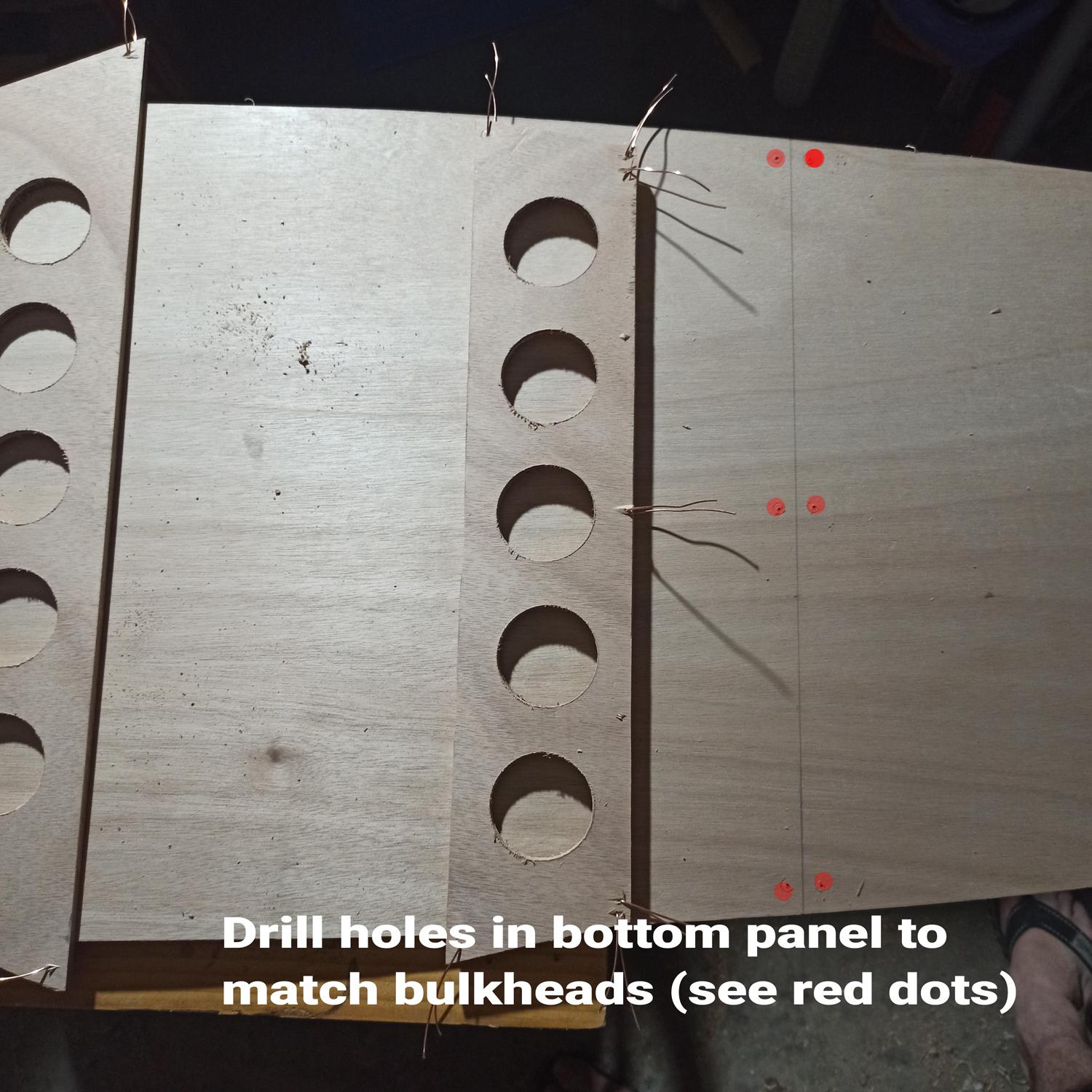
Tools:
- Wire snips
- Pliers (Preferable needle nose)
- Drill holes for wires that assemble the hull as shown in the images (holes in three spots along the bottom edge of each bulkhead and two spots along the sides. The exact locations of these holes doesn't need to be mm perfect and more holes can always be added later.
- Hold the bulkheads roughly in place over the bottom panel (use the straight lines drawn on the bottom panel earlier as a guide) drill a hole both sides of this line roughly where the holes in your bulkheads have been drilled. (see image with red dots)
- Cut lengths of copper wire to approximately 100mm long. You will need plenty of these so it helps to cut a lot at the starts.
- Assemble the hull using wire through the predrilled holes. Be sure to check you have the molds in the right order and the right orientation. If something doesn't fit right, it's probably not right.
- At first twist the ends of the wire together only enough so that it won't come out of the holes, don't tighten the wire enough to remove all gaps between panels.
- Don't be afraid to drill new holes for wires if the first set don't line up correctly. These holes will all be filled in later.
- For a better fit plane the inner edges of the joint for the hull sides to the bow as shown in the left of the below images. This will give you a bit more surface area to glue to. I fit the bow into place last of all.
- If there are obvious gaps between sections as shown in the far right of the three images below, you can add extra holes and wires to help close these up.
- Once you are happy there are enough wires to bring all the panels together when tightened, start to twist the wire together tight using pliers - Work on both sides together working your way along the boat starting from the transom rather than stitching one side at a time.
- You may find that there are some spots on the boat that still have gaps. Again don't why away from drilling more holes and using more wires. Sometimes you may need to use a slightly different angle between holes to bring the panels together. A bit of trial and error here will help you learn how best to do this.
Fillet the Joints With Glue - (1hr)


Tools:
- Disposable gloves
- Sandpaper
- Fillet the inside of the joins with high strength epoxy glue. Try and avoid touching the wire with glue so that all of the wire is easy to remove later.
- Take a scrap piece of wood from your many offcuts and round over the end like shown in the image here. The diametre of the curve isn't critical and won’t be seen. But this will guide the size of the glue fillet inside the hull.
- You can be as clean and meticulous or messy as you like here as the fillets on the inside of the boat won’t be seen again (but you will know they are there…) I like to run my fillets with enough glue that a little bit of a line forms on the outer edge of the fillet. I usually go around and clean up this line once I'm done with all fillets.
- Read the instructions on your epoxy and follow them as closely as you can. Poorly mixed epoxy won't set right. Epoxy that isn't given enough time to set will move and leave you with poor joints.
Remove Wires and Complete Fillets (1.5hr)
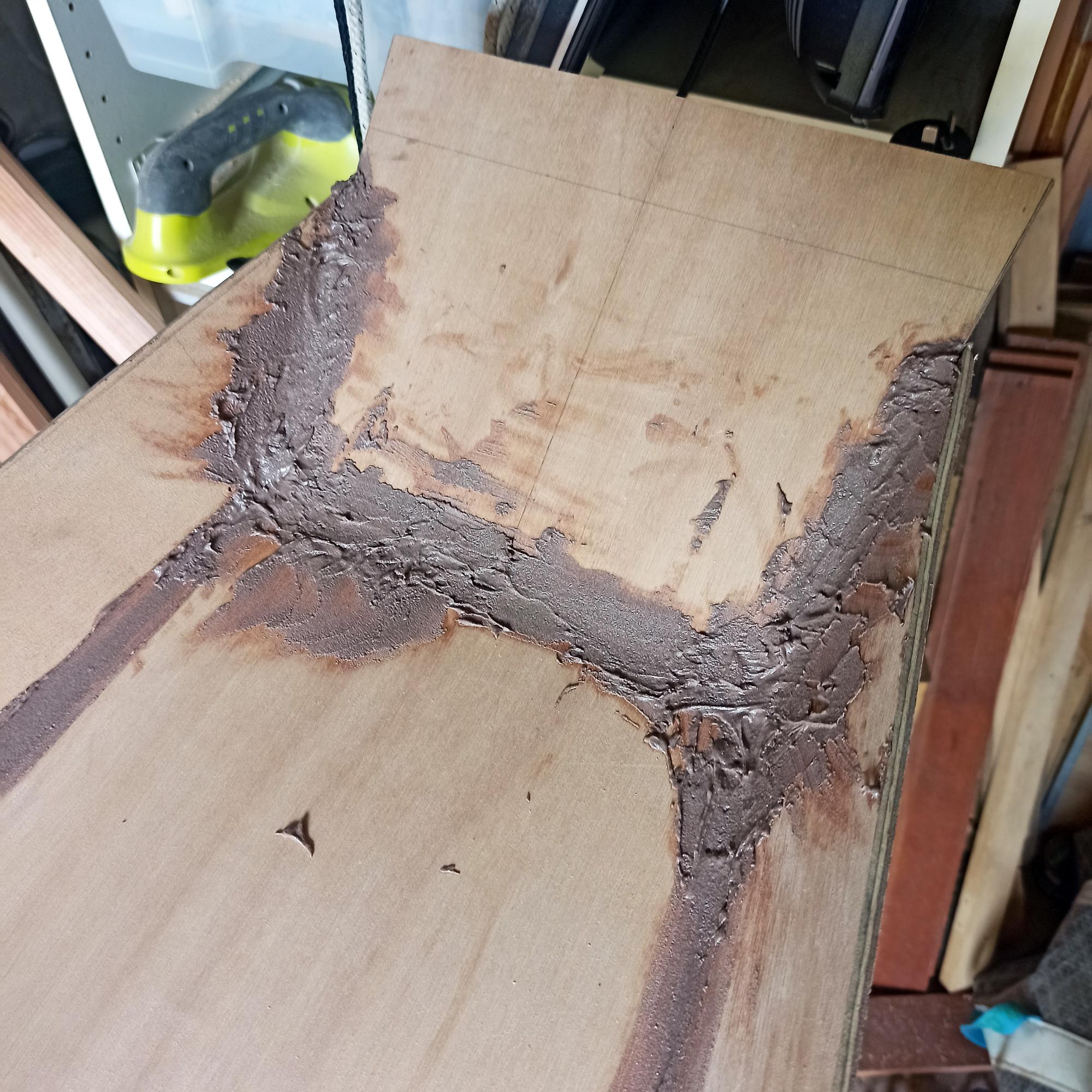


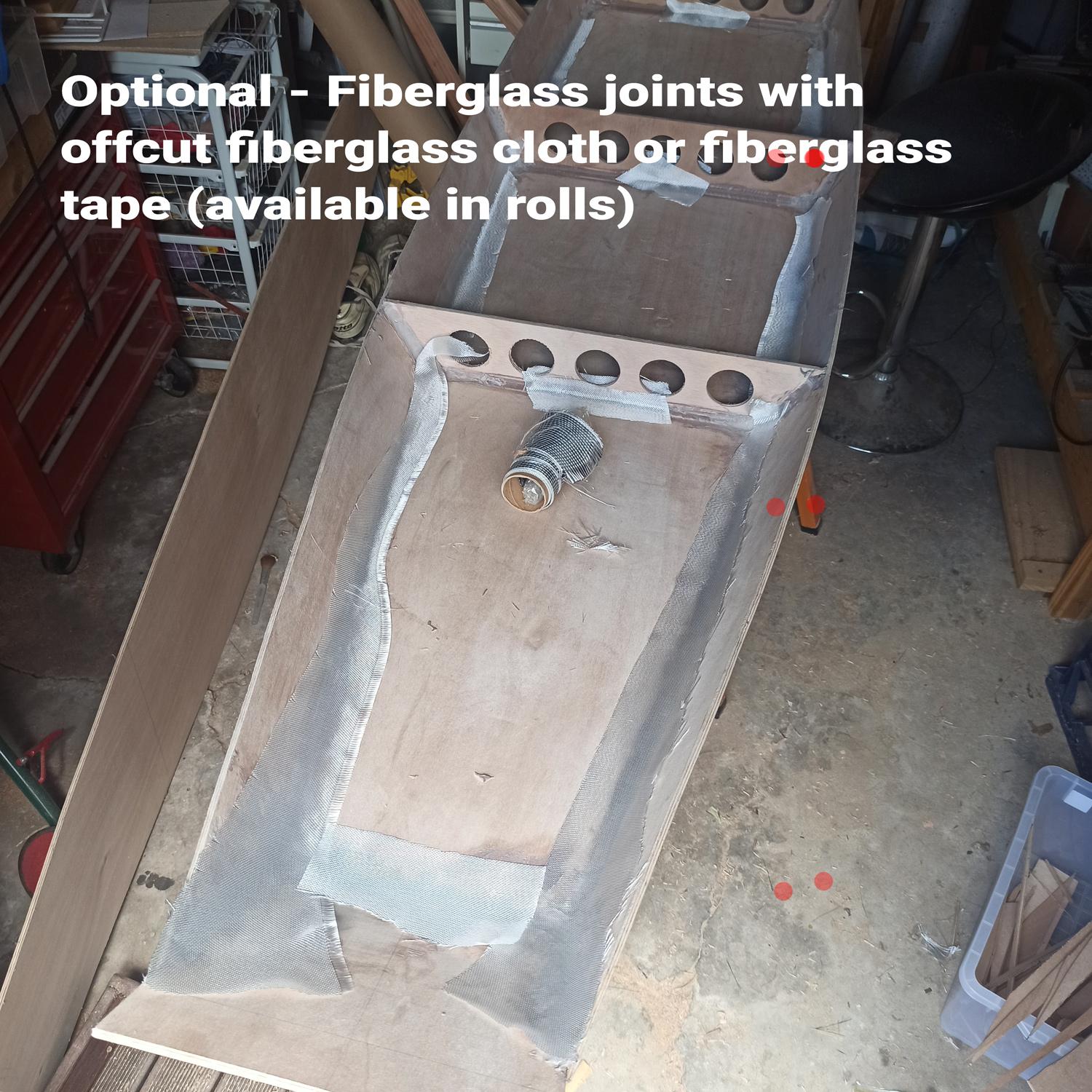
Tools:
- Wire snips
- Sandpaper
- Hand Plane
- Hand saw
- Paintbrush (for fiberglassing)
- Scissors (for cutting fiberglass)
- Remove wire by cutting inside the hull and removing pieces with pliers. Some pieces may have a little bit of glue touching them but with a bit of force with the pliers these pieces should all come free.
- The hull is strong enough at this stage to be moved around so you can flip the boat over and plane the edges of the hull bottom to be level with the sides of the hull. Some areas will have more to take off than others but be careful not to plane the flat of the hull sides as this will show up later on the boat.
- You can add a slight round to the edges of the hull in this step. Sharp corners don’t feel nice to hold so just roll the edge over with a few strokes of your plane.
- Fillet the remaining sections of hull with High strength epoxy glue. You can reuse the same fillet stick as the first time around just giving it a sand to make it smooth before you start the process again.
- Fill the voids on the outside of the hull as well covering all the holes where the wire was previously.
Optional (but highly recommended) fairing and fiberglass tape - At this stage you can sand down the first fillet to an even curve and fill with more glue or lightweight filler powder epoxy. If you are planning to fiberglass tape the inside of the joints like most stitch and glue builds recommend, this extra effort will make the joins stronger. You will need to complete the fillets in this step before you can apply the fiberglass tape.
Fiberglass tape the joins inside the hull. Your boat will last longer if you do this step but it may not be required if the boat isn't going to be used in any too demanding conditions, or if you’re not expecting an extended lifetime. For the prototype I fiberglass taped not every join but some that I felt were critical for a bit more strength as shown in the images on this step.
The bow in particular doesn't have the greatest joint strength. This section was treated to some extra fiberglass cloth as shown. in the images here. Overlay some small pieces of cloth along the joins.
If you have built a few boats like me you will likely have some scraps of fiberglass cloth. I used some offcuts to trim up pieces to tape the joints in the prototype. If you don't have offcuts like this you can buy fiberglass tape to do this job. 40mm or more gives good coverage of the joints if you are careful with placement.
Make sure you plan where all your bits of fiberglass will go before mixing resin otherwise things will get messy!
Prepare Hull for Deck (Approx. 1.5hrs)
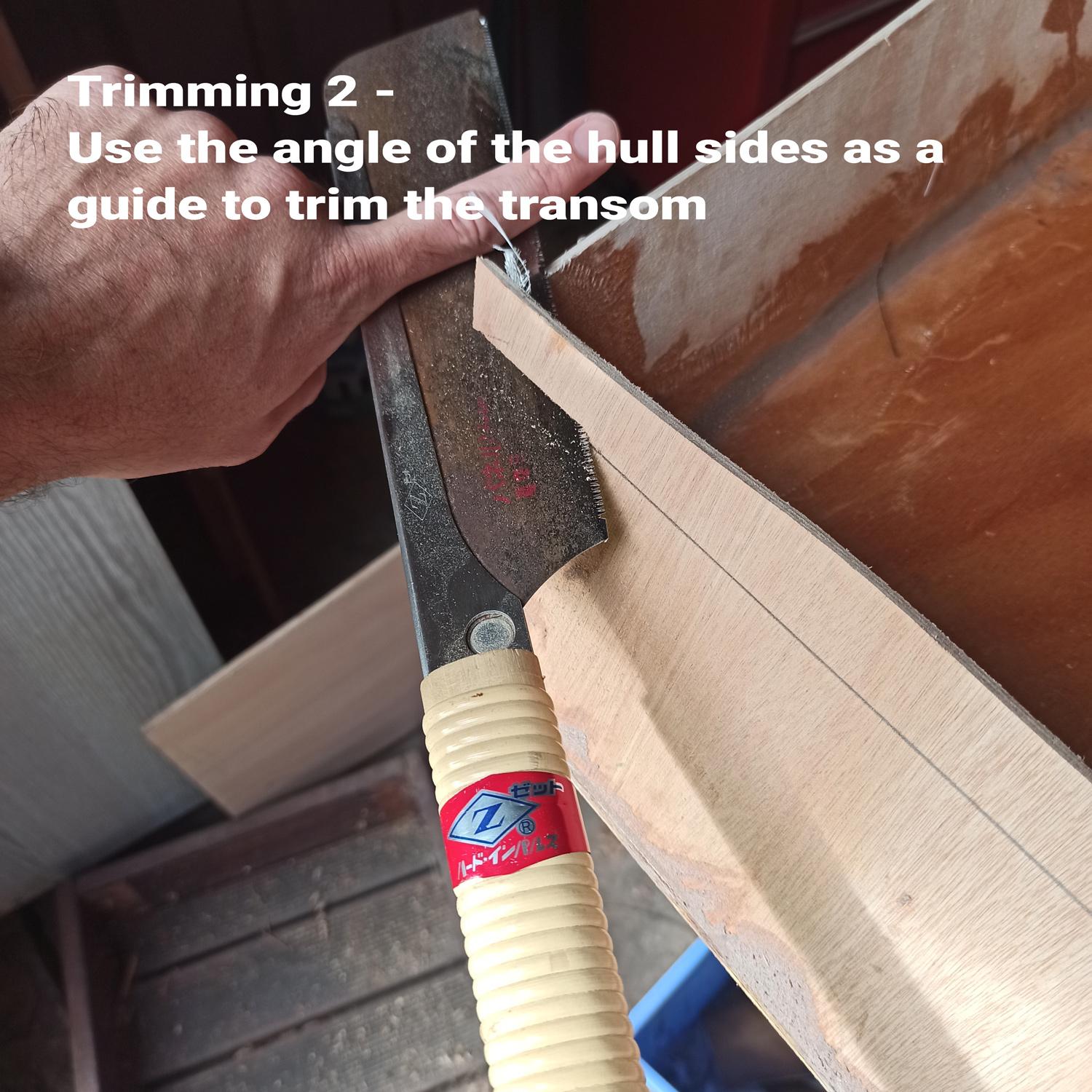
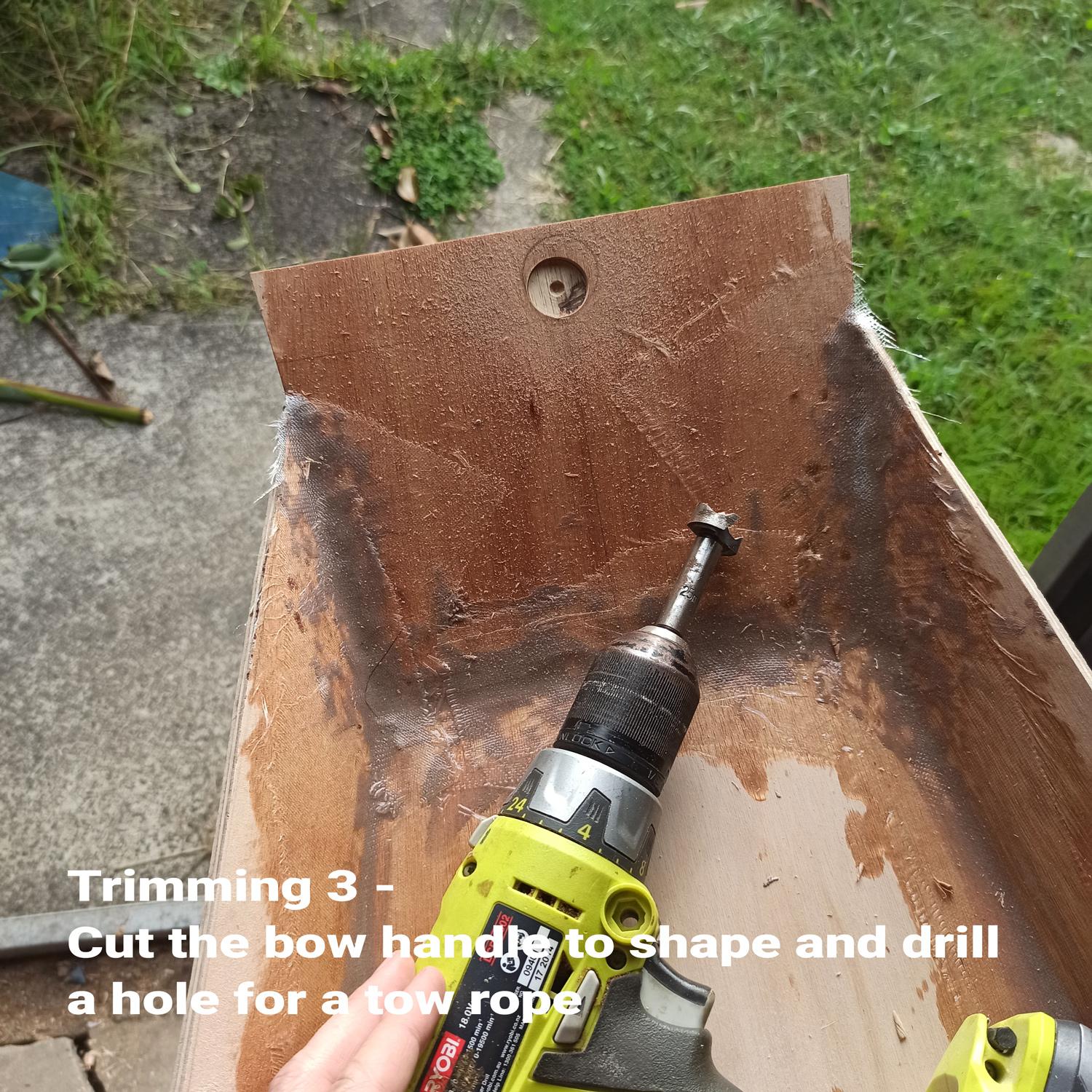
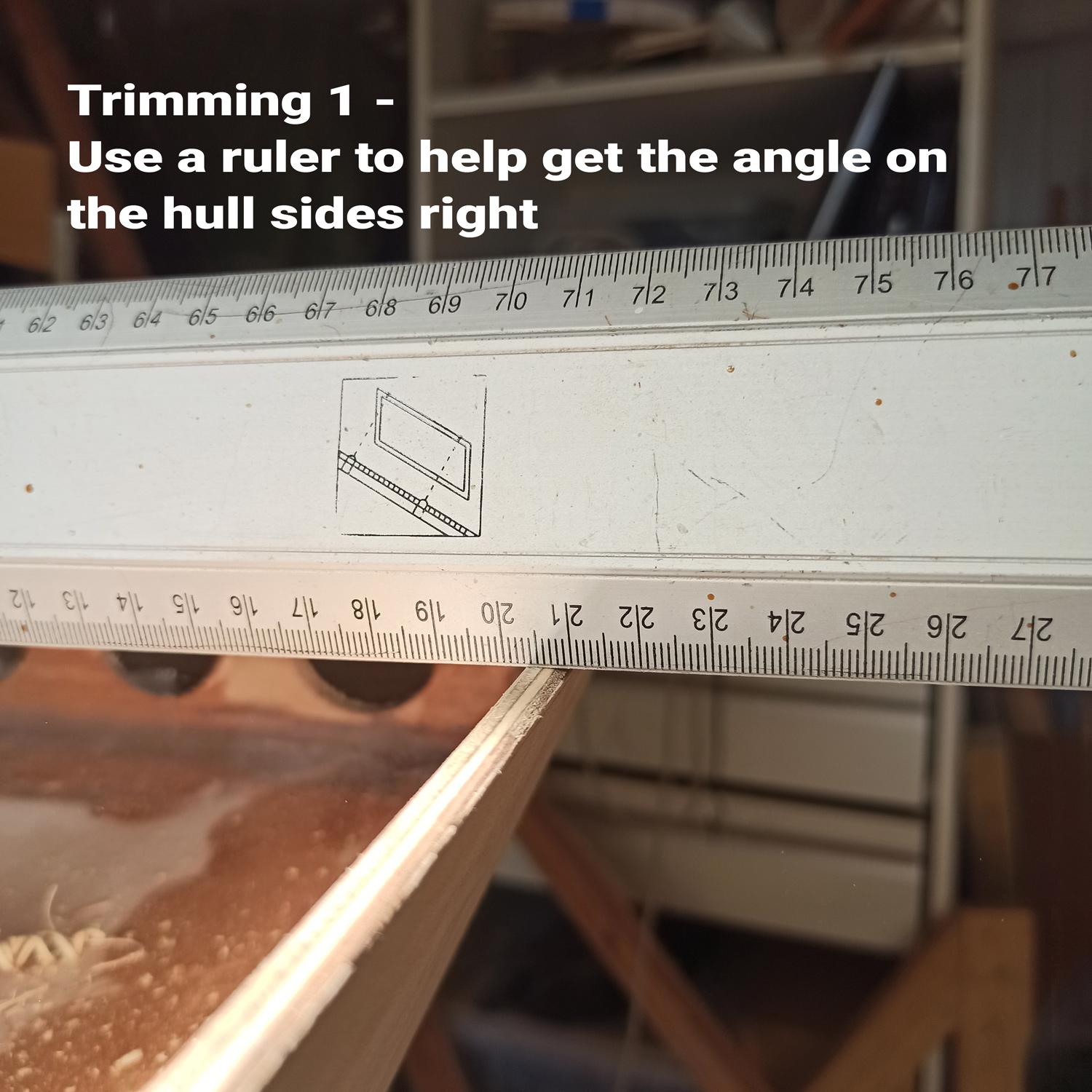
Tools:
- Sandpaper
- Drill + holesaw or large bits
- hand saw
- Plane
- 1m ruler
- Clean up your glue fillets as much as you like. Remember on the inside no one will see them! If you are fiberglassing the joints then fairing these fillets will be more important
- Optional: to improve longevity coat the inside of the boat with epoxy resin. This is not a must but in the event that water does get into the boat this will help protect the material.
- Trim the hull sides, bow and transom flush for an even curve where the deck joins ontop. Use a straight edge to assist with this step (see image trimming 1) running the line across the hull as shown.
- When trimming the transom use the angle of the sides of the hull as a guide. Keep the piece that is cut off and glue this to the inside of the transom. Use the cut edge to match up with the angle on the transom to reduce trimming later on. (See trimming 2 image)
- If you would like to at this stage you can cut in a bow rope attachment point like I did on the prototype as shown in the images below. I used a forstner bit to drill the hole but a large drill bit or small hole saw will also work. (trimming 3 image)
Add Deck Supports (1hr)
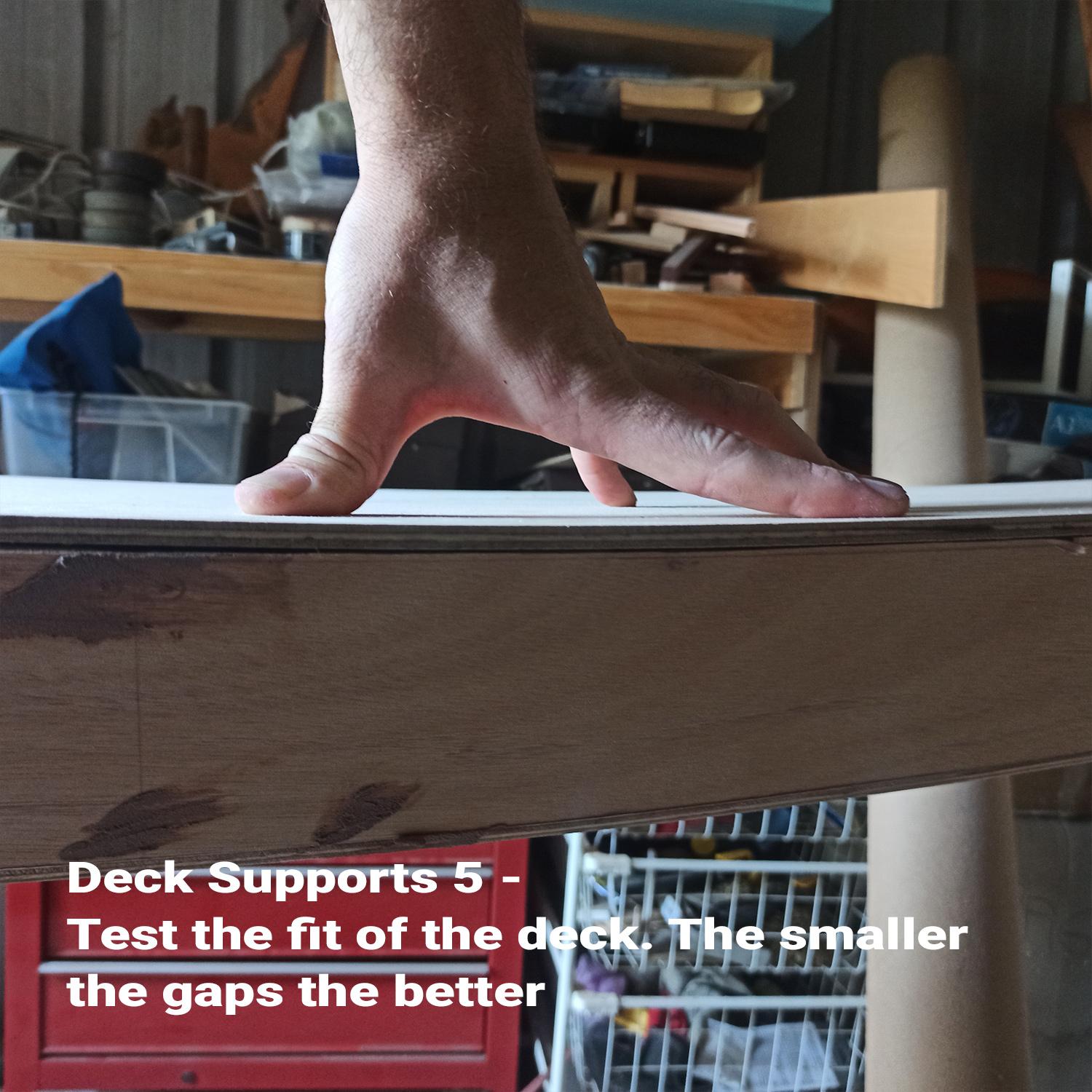
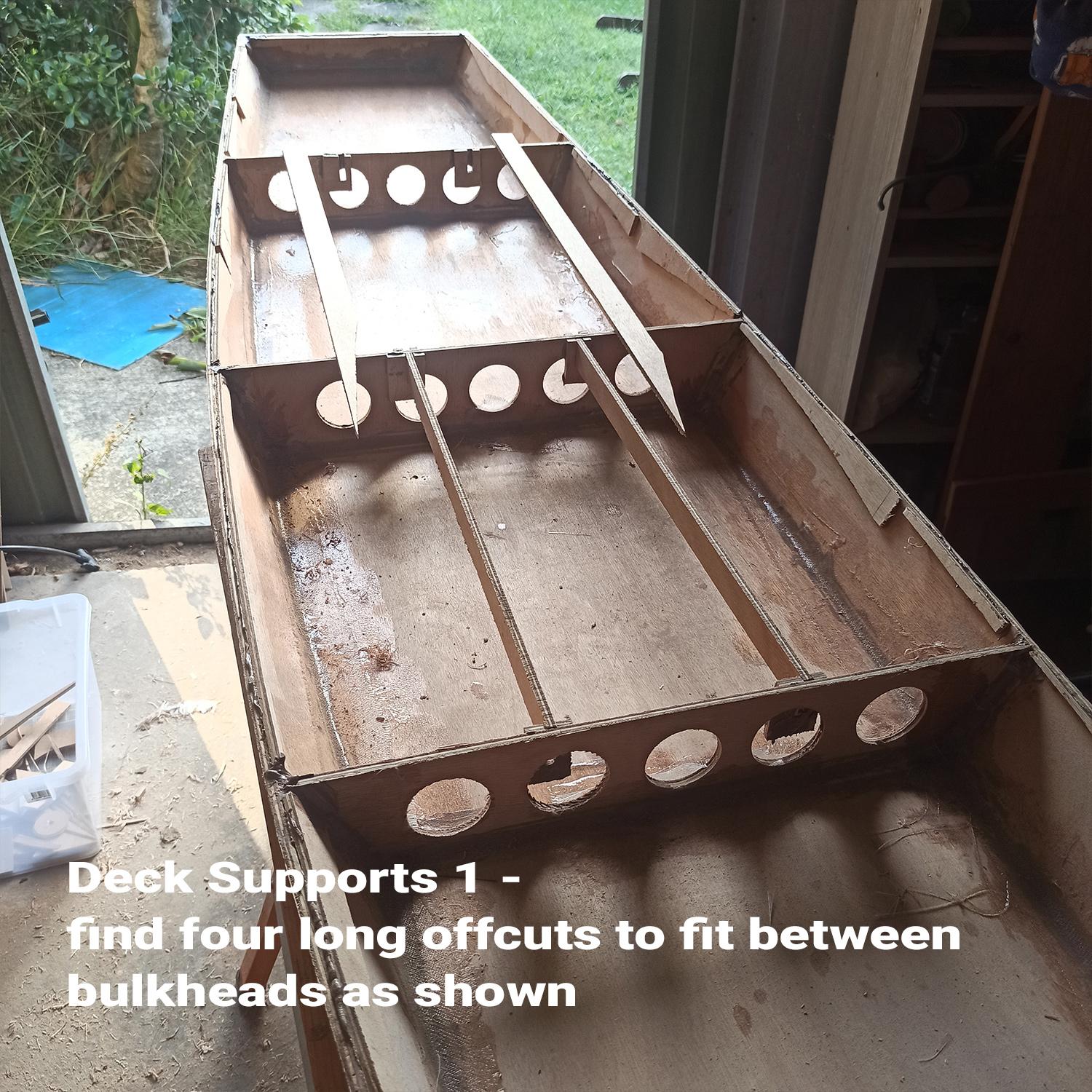
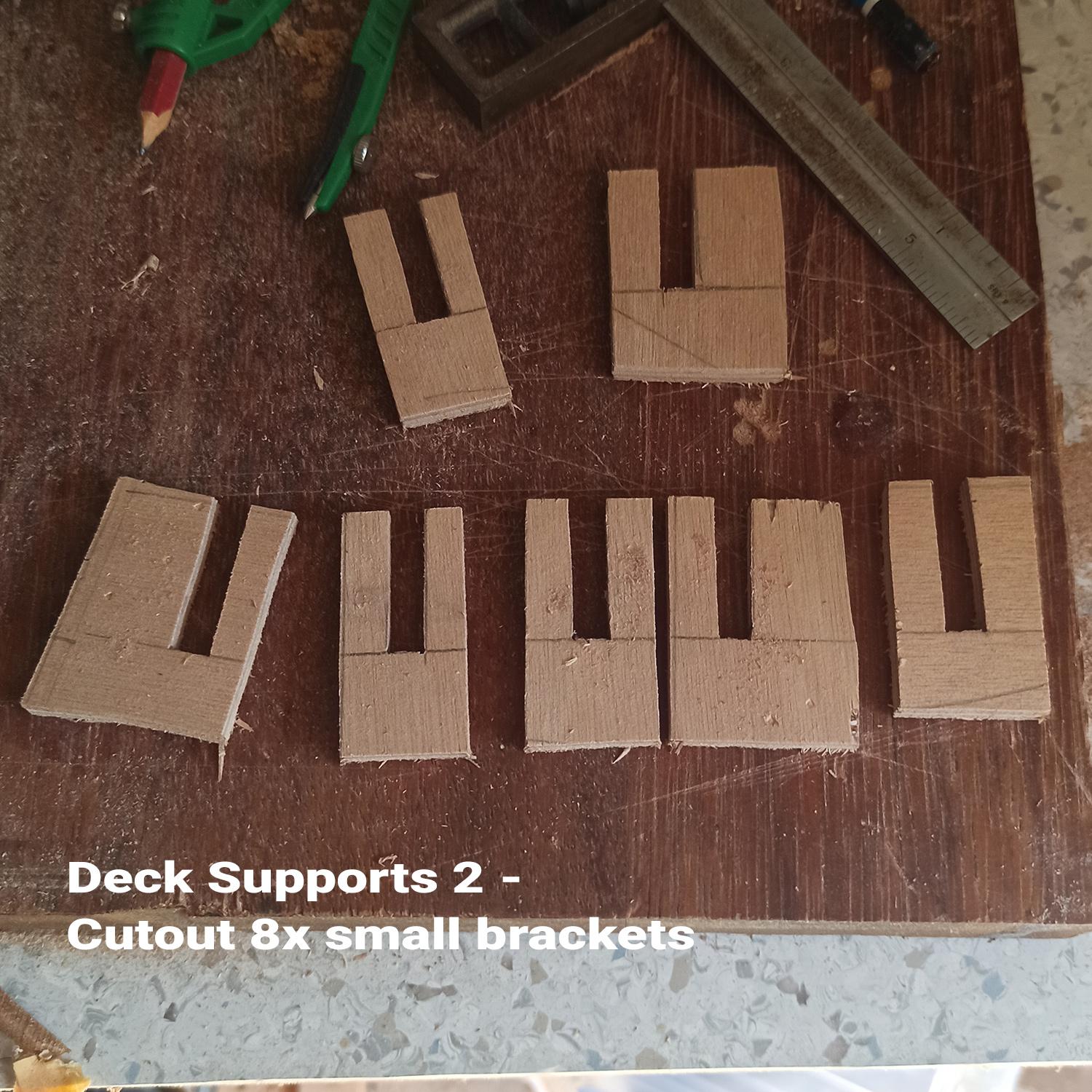
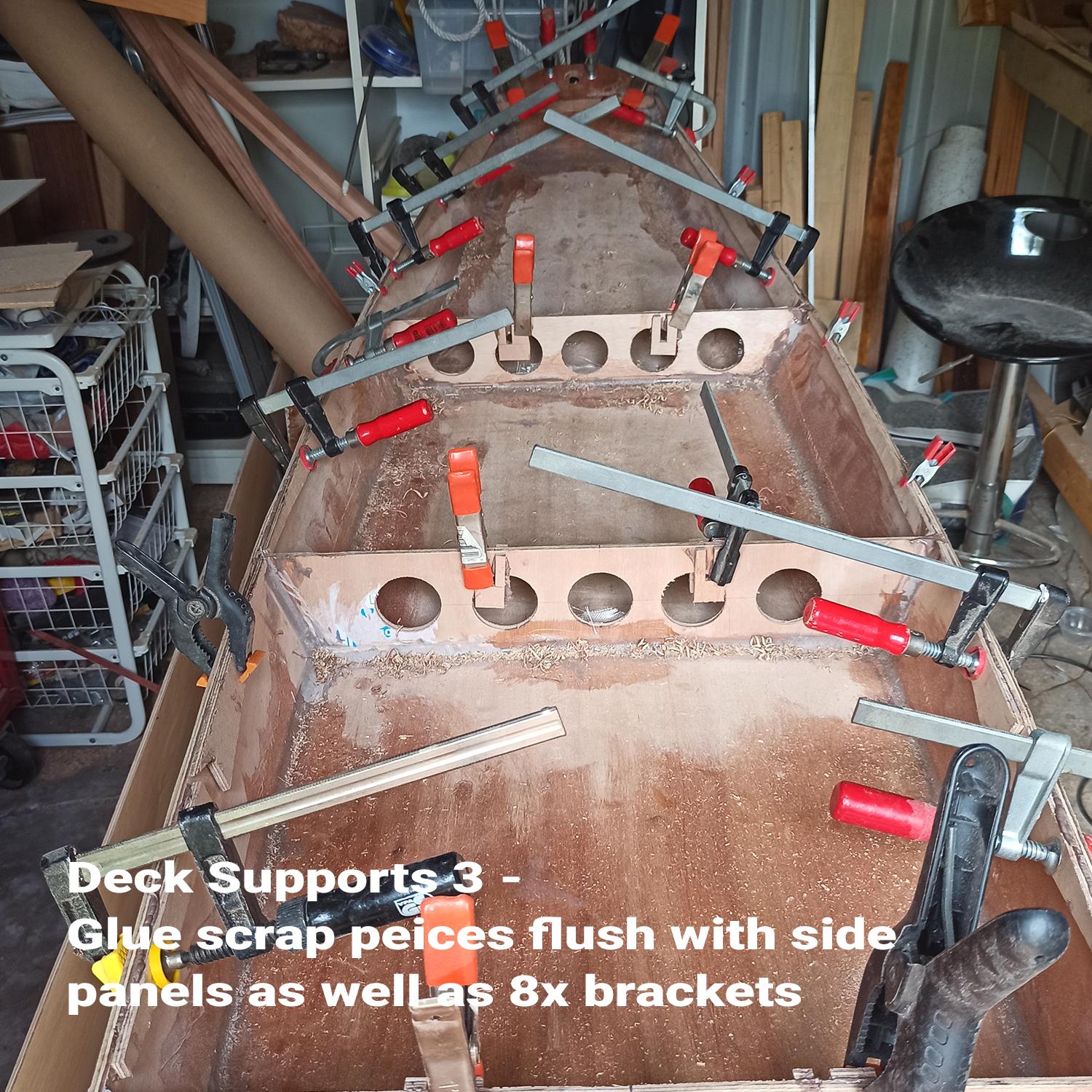
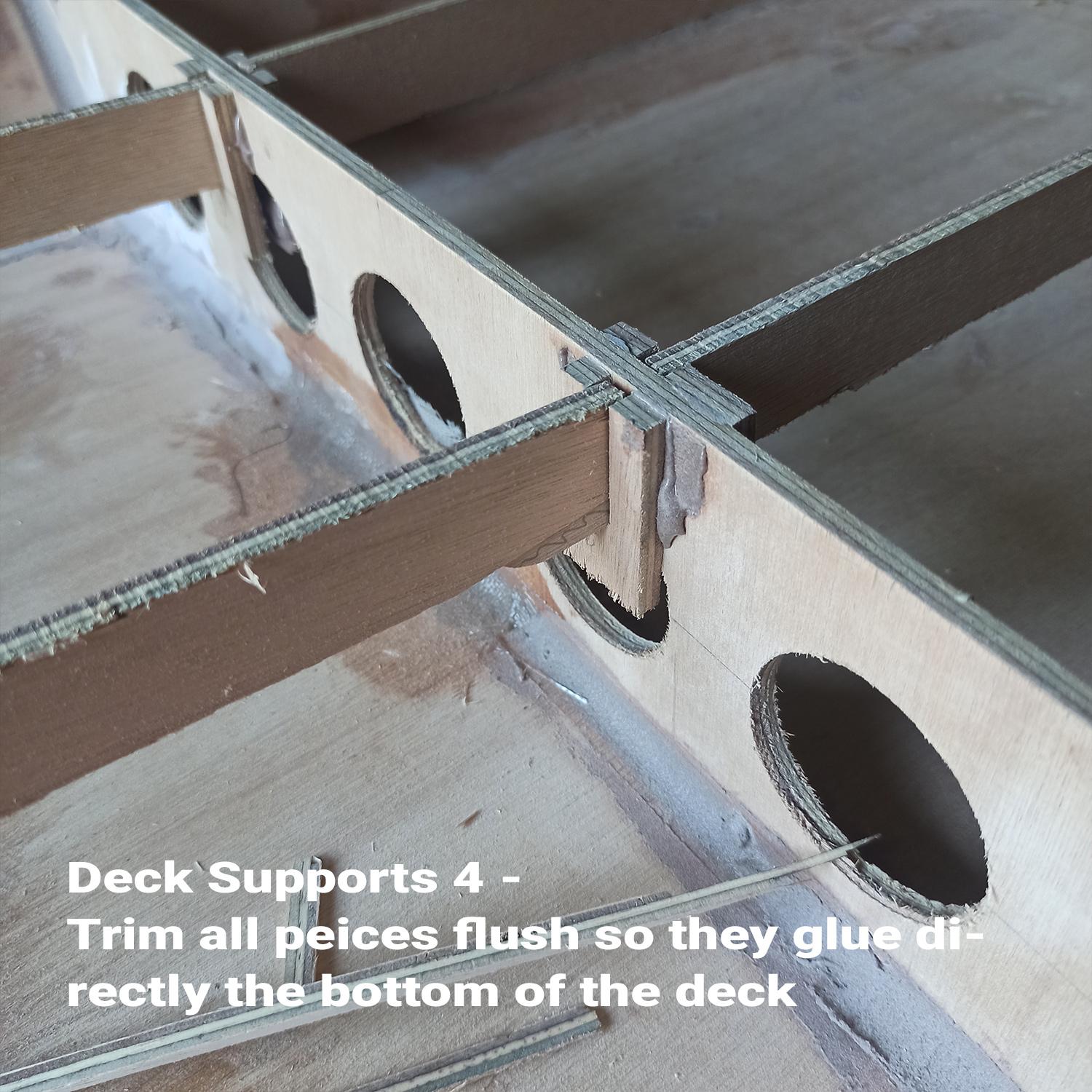
- Take the four longer pieces of scrap that you saved from the earlier stages. These pieces will be used to add a bit more strength under the deck area where a rider will sit or possibly stand on the board. (See deck supports image 1)
- Mark 80mm from the centre line of each bulkhead on the top edge. Cut your four long pieces to fit between these points as shown (Mark which one goes where as they might not all be exactly the same size)
- Find more scrap and create little brackets as shown here. The exact dimensions of these aren’t critical but you will need 8. Cut the groove to the width of your material and the depth of the four pieces above. These will be glued to the bulkheads to give the four long pieces a place to attach to. (see deck supports 2)
- Take some of your scrap wood and reinforce the hull sides as shown in the image (Deck supports 3 image). It's best if these pieces are trimmed to approx. 10mm wide to minimise weight but larger pieces are okay. The prototype used a mix of offcut widths as you can see in the images. Glue these in place with high strength epoxy and once cured trim to fair the timber as above. These extra pieces add more surface area for the deck to glue to.
- Glue the 8x brackets in place as well, lining up the mark on the top of each bulkhead with one side of the slot in your brackets.
- Once set, glue your four long pieces in place taking care to try and align the top edge with the bulkheads. Plane these down to fit after the glue cures if need be.
- Once dry plane these reinforcing pieces flat with the edge of the hull. Use the same methods as earlier using a ruler to judge the angle. (see deck supports 4)
- Test how smooth your curves are by laying the deck down in place. Press the deck down and check if there are gaps between the hull sides and lower edge of the deck. You will be able to spot high points here and plane these down further to make a smooth curve. (See deck supports 5)
- If you plan to varnish the hull and this deck joint take your time here and try to get the joint as close as possible.
- If you plan to paint the boat them you can hide a multitude of sins… It’s still good to get the joints close to a snug fit but you're glue will fill gaps as well.
Add Draining Hole and Fit the Deck in Place (approx. 45mins)


Tools:
- Drill + bits to match bung size (Hole saw or forstner bit)
- Weights
Fitting the bung:
- Before you put the deck on, drill out a hole for your bung or similar air vent. Bungs are readily available at boat shops or online. They serve two purposes, firstly the allow the hull to be opened up when out of the water to vent air (on hot days in particular the air inside the hull will heat up and can stress joints in the boat from the air expanding.) and secondly to allow to drain water from inside the hull if there are any leaks (hopefully not)
- Take your bung and have a look at the geometry of the fittings. I installed mine direct center near the base of the transom. Look closely at the angle that tis piece will be fit at to make sure you drill this hole high enough to fit without hitting the bottom of the hull on the inside.
- I fixed my bung in place after the boat had been painted so that it doesn't get covered in paint. It's a simple matter of drilling two holes and screwing the bung in place with either waterproof flexible sealant as glue or just more of your epoxy resin thickened as glue.
Fitting the deck:
- Dry fit the deck in place making sure it covers all of the hull. Check where weight is needed to hold the deck down flush with the rest of the boat. Paint tins or similar are great for this application.
- Take the deck off and apply high strength epoxy glue to all surfaces where the deck will touch. Be fairly generous with your glue here as this is all that will hold the desk in place.
- Locate the deck back in place and check alignment all around the boat. Once you are happy the deck is in the right place apply your weights and clamps to hold everything in place. Check all around the join again and see if more clamps or weights are needed in any particular place.
Hull Fairing and Finishing (2+ Hours)
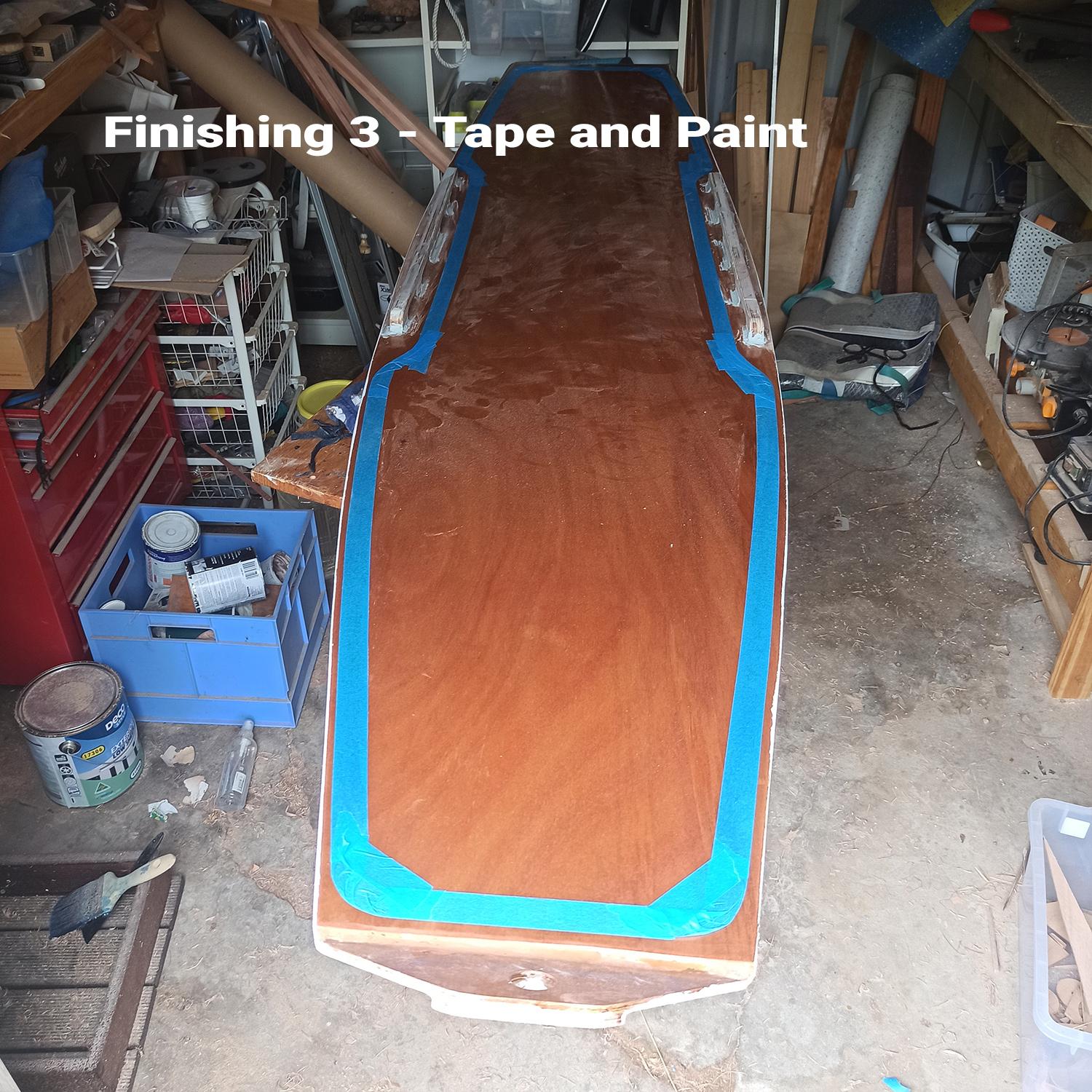
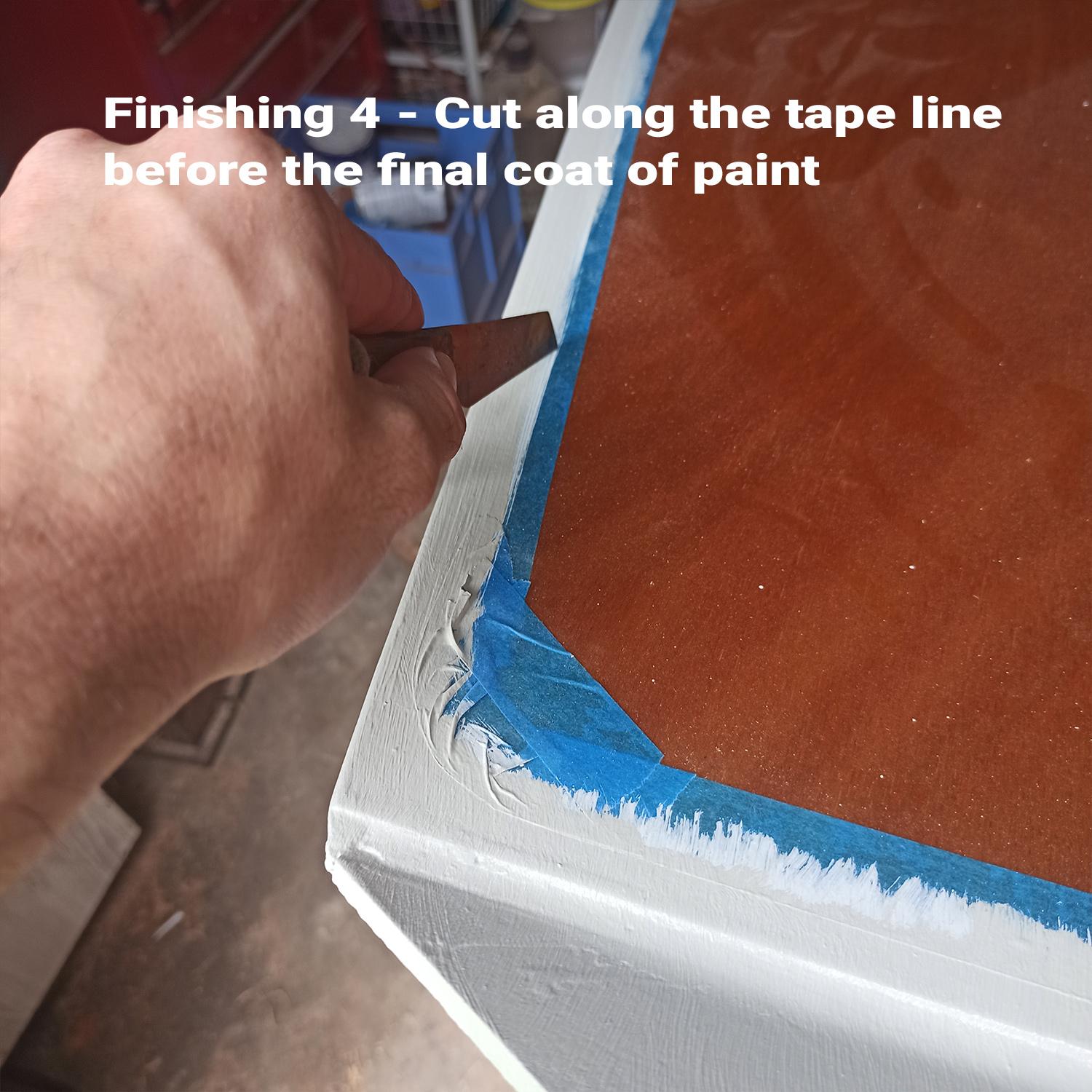
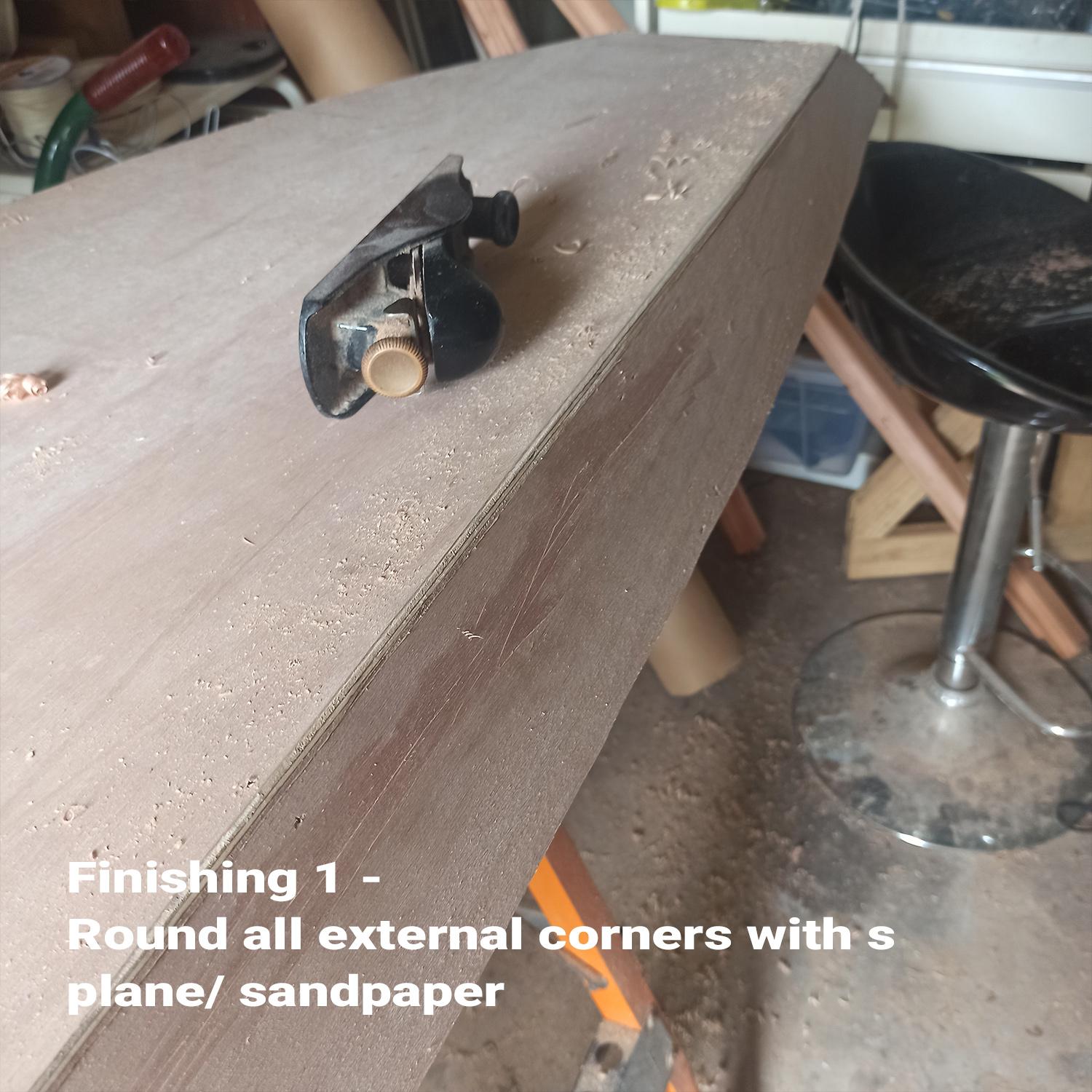
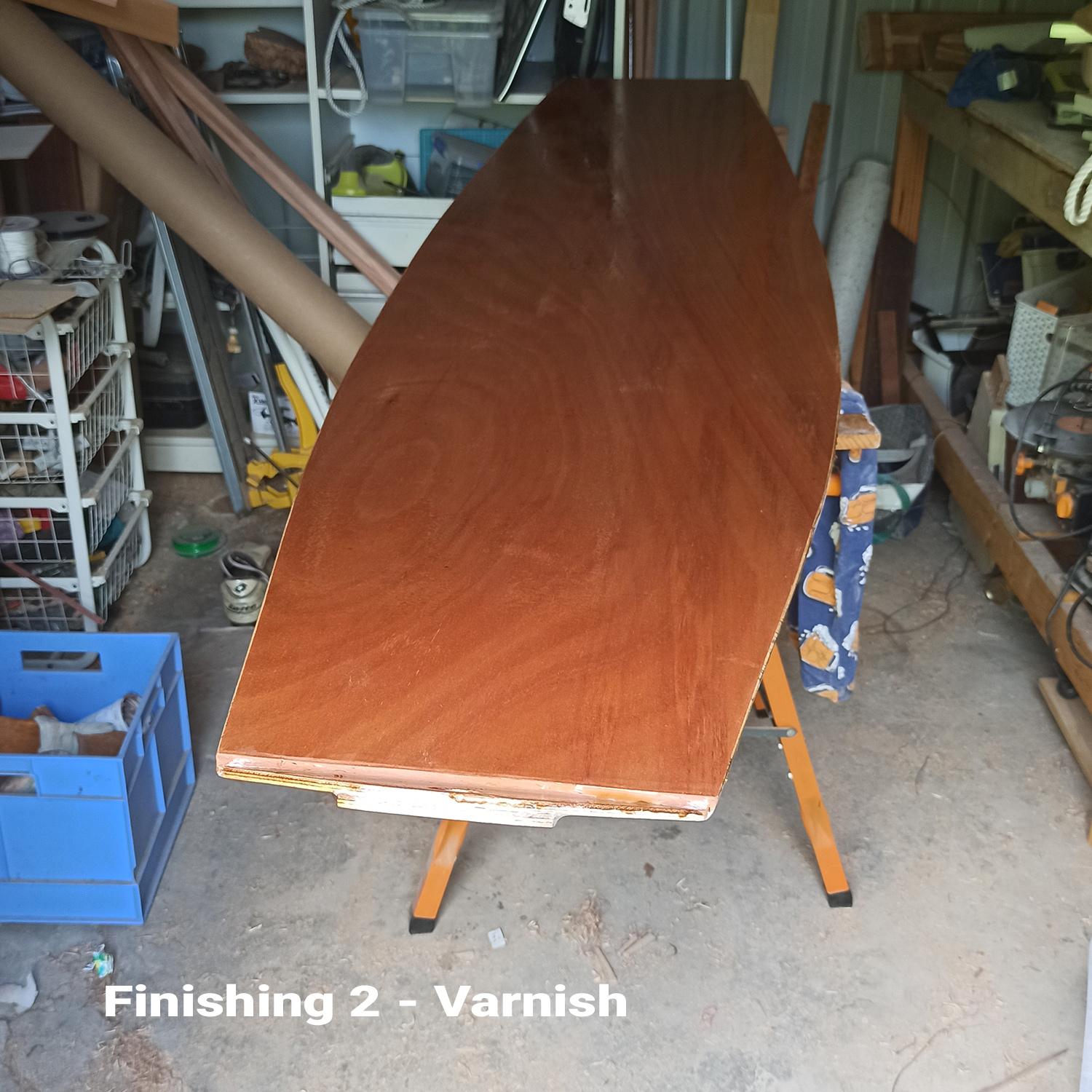
Tools:
- Tape
- Paintbrushes
- Knife
- Trim edges of deck with a slight round, Don’t take too much off here but make the round comfortable to hold. (see finishing 1 image)
- Apply filler to any gaps or voids to make the surface smooth all over - this is another one of those steps that will take as much time as you can bear. There becomes a point where you will be happy enough with the smoothness of the finish.
- A note on fairing: it has been said that building a boat is 5% building 95% sanding. With this project that shouldn't be the case. The more accurate you are through all of these steps the less sanding you should have to do. The less particular about a super smooth finish the less sanding you will have to do even more so. The finish on my boat has some imperfections and brush strokes from the paint. It's a kids boat, it's going to get bashed around and likely will need repairs!
- Give the exterior of the hull a light sand and varnish/ paint as desired. Given the construction method there are going to be holes filled in the sides and bottom of the boat. The deck should be clear. I have chosen to varnish the deck and paint the rest. If you don't mind showing off the filler and filled holes varnishing the whole boat is an option and means less different paints to mess around with.
- First I varnished the deck. You should do this with your handrails installed (if you are adding these) first. Glue the handrails in place and fillet as described in the optional instructions in step 4. (the images here (see finishing 2) show the first coat of varnish went on before I put the handles on). Sand lightly between coats and follow the instructions on your varnish, number of coats as many steps here is up to you. What level of finish are you looking for?
- Tape your desired paint line with painters tape. Feel free to add interesting shapes or designs here with tape. This stuff peels off easily but leaves a nice crisp line. Be sure to press down the paint edge before painting and check on some of the tight curves a few times. The tape can lift out of place. (see finishing 3)
- This tape is used to create a crisp line up paint up to your varnish. Cover all the wood outside of the tape but be careful not to go inside on the area you plan to leave varnished. If you know you are sloppy you can always add another layer of tape.
- Usually you are meant to remove this tape between each coat, but that can be time consuming if you plan to put a number of coats on. (follow your paints instructions, my boat has two coats of undercoat and two of topcoat. It's not a great quality finish but it's a kids boat that will be knocked about!) Peeling the tape away once the paint sets risks chipping. I like to leave the tape in place till my last coat.
- Just before the last coat take a knife and trace into the paint along the edge of the tape as shown. The paint below will chip if you peel the tape without doing this. (see finishing 4)
- Paint the final coat covering the edge of the tape and then peel all the tape away before the last coat dries. While painters might cringe at my approach, I feel it saves time and it's worked well for me so far!
Leftovers, Next Steps & Optional Ideas
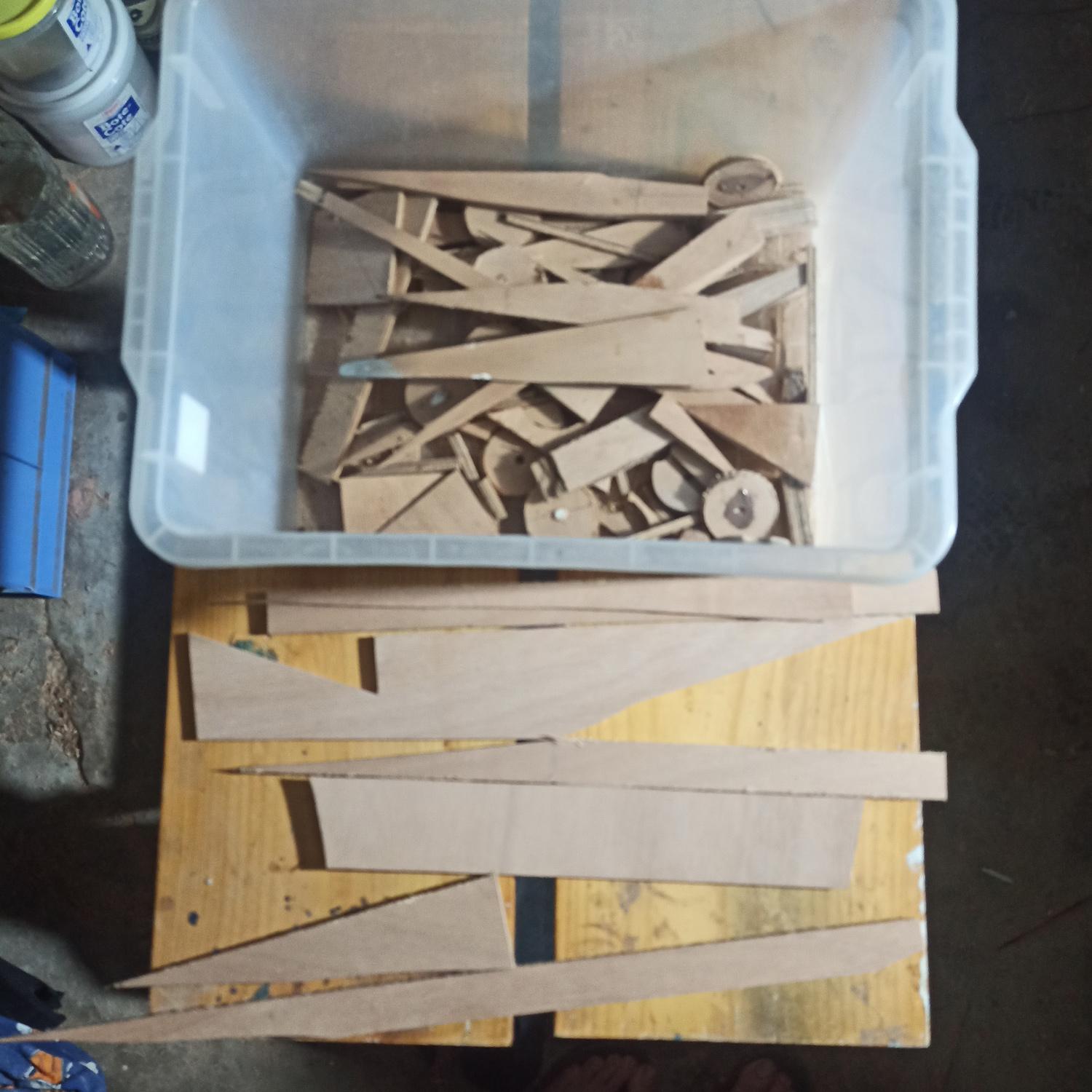
It's pretty wet in Sydney Australia as this project comes to a close. The motivation to complete this project was the One board/one sheet competition from Instructables which this entry is just going to be completed in time for. Unfortunately that means I haven't been able to give the OSSKI a good test in the water yet. - Updates to come in this area!
So far the boat has been tested in a pool and it seems to float nice and high. My daughter is about 20kgs at the moment and her weight sitting and standing on the board didn't sink the waterline by much at all. I'm keen to test out the weight capacity.
Leftovers:
The image here shows my bucket of bits. All the offcuts from this job that I could pickup, little slithers of material and all, I did. This bin became my go to for stirring sticks in paint and mixing glue. There isn't much material left over but if someone was a bit more thrifty than me with their cutting it does look like there may be enough material here to get a kids size paddle. Rather than a hole saw to lighten the bulkheads maybe a scroll saw could cut larger sections out of this to be glued together for paddle blades...
Some other ideas for what to make from these leftovers could be...
- Cleats: gluing up a few little bits would provide more than enough material to make some little cleats like in this video
- Rope attachement points / ankle strap atachments: The holes cut from the holesaw in the bulkheads could be used as the base for some attachment points for ankle straps etc. Cut through the middle of one and glue it to another one leaving a 6mm gap in the middle... sand the edges and glue this down on your deck you would have a 6mm hole to feed some rope through.
- Removable fins: The skeg on this boat is quite small at the moment. If a bigger fin is needed to help steer the boat there is enough material here to glue up a few bits! Make a bracket that fits over the existing skeg and bolt it in place to make it removable.
Got any more ideas for what else could be made for this boat from these leftovers?
Paint idea:
A friend I may have convinced to build a boat on the first day meeting him built a Michael Storer quick canoe. He had his kids do some little drawings in a section of the boat that he varnished over to preserve. I think this is a great idea to involve your kids in the project particularly if the boat will be theirs!